Economic Studies: Analyzing Market Forces and Environmental Factors
VerifiedAdded on 2019/12/03
|17
|5682
|231
Report
AI Summary
The provided assignment content consists of various academic articles and books related to business, economics, and policy. The articles cover topics such as competition policy, market forces, environmental purchasing, and global business cycles. The books include texts on leisure marketing, macroeconomic policy, and the leaderless economy. Additionally, there are two online sources: a British Airways business review and an article discussing how market forces shape organizational responses.
Contribute Materials
Your contribution can guide someone’s learning journey. Share your
documents today.
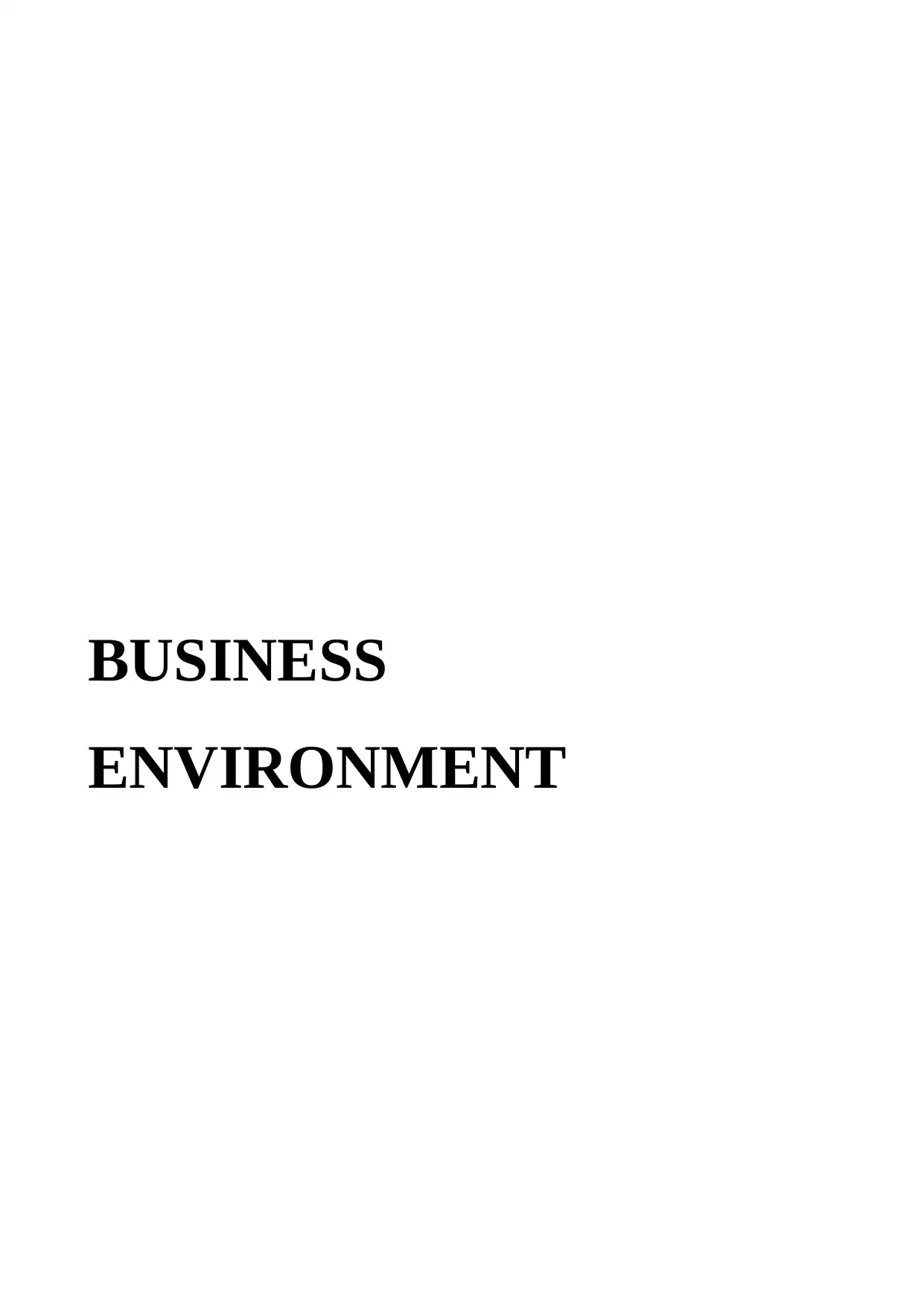
BUSINESS
ENVIRONMENT
ENVIRONMENT
Secure Best Marks with AI Grader
Need help grading? Try our AI Grader for instant feedback on your assignments.

Table of Contents
introduction...........................................................................................................................................3
TASK 1.................................................................................................................................................3
1.1 ...................................................................................................................................................3
1.2 ...................................................................................................................................................4
1.3 ...................................................................................................................................................5
TASK 2.................................................................................................................................................6
2.1 ...................................................................................................................................................6
2.2 ...................................................................................................................................................7
2.3....................................................................................................................................................8
TASK 3.................................................................................................................................................9
3.1....................................................................................................................................................9
3.2....................................................................................................................................................9
3.3 .................................................................................................................................................10
TASK 4...............................................................................................................................................11
4.1 .................................................................................................................................................11
4.2 .................................................................................................................................................12
4.3 .................................................................................................................................................13
CONCLUSION..................................................................................................................................14
REFERENCES...................................................................................................................................15
introduction...........................................................................................................................................3
TASK 1.................................................................................................................................................3
1.1 ...................................................................................................................................................3
1.2 ...................................................................................................................................................4
1.3 ...................................................................................................................................................5
TASK 2.................................................................................................................................................6
2.1 ...................................................................................................................................................6
2.2 ...................................................................................................................................................7
2.3....................................................................................................................................................8
TASK 3.................................................................................................................................................9
3.1....................................................................................................................................................9
3.2....................................................................................................................................................9
3.3 .................................................................................................................................................10
TASK 4...............................................................................................................................................11
4.1 .................................................................................................................................................11
4.2 .................................................................................................................................................12
4.3 .................................................................................................................................................13
CONCLUSION..................................................................................................................................14
REFERENCES...................................................................................................................................15
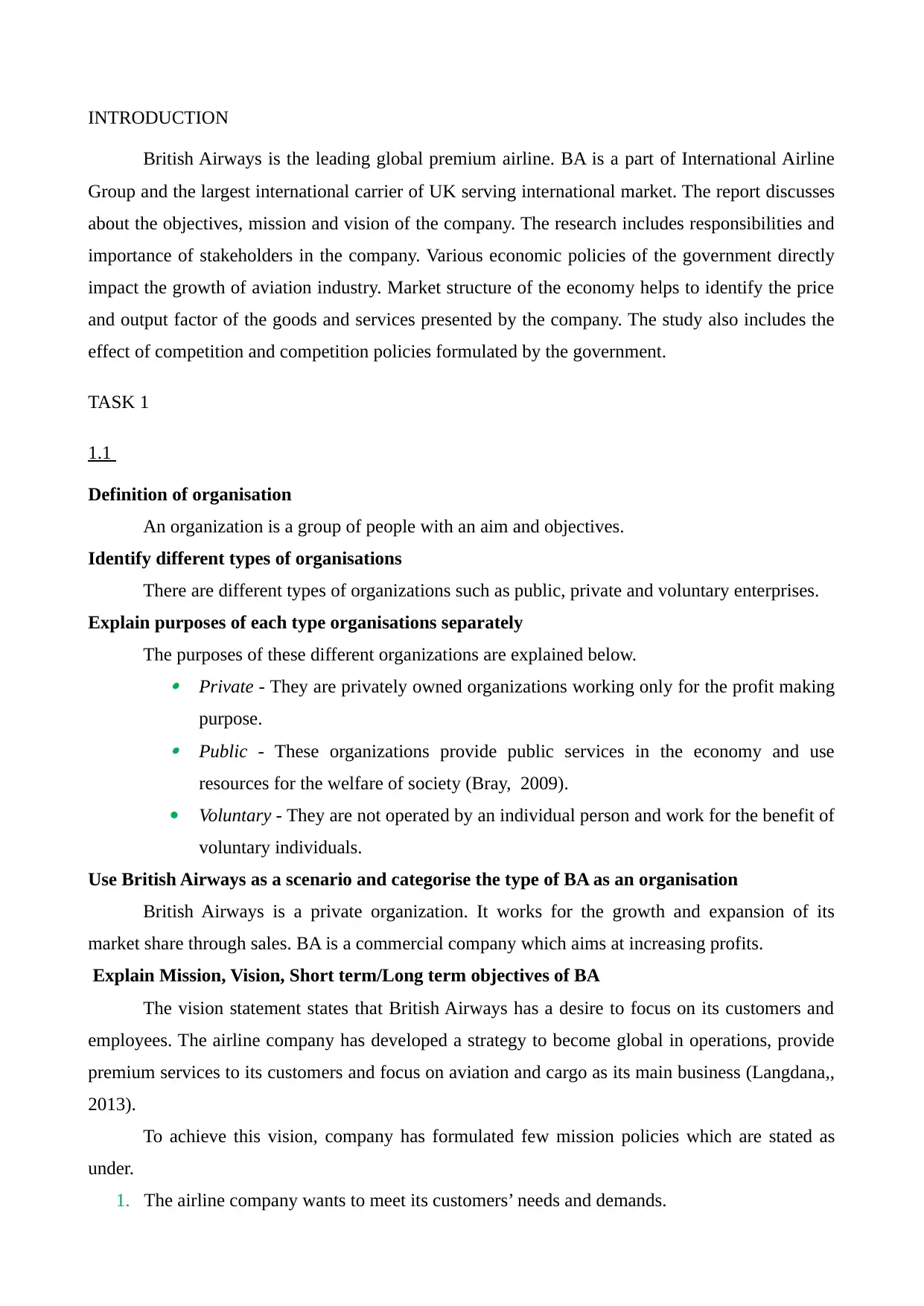
INTRODUCTION
British Airways is the leading global premium airline. BA is a part of International Airline
Group and the largest international carrier of UK serving international market. The report discusses
about the objectives, mission and vision of the company. The research includes responsibilities and
importance of stakeholders in the company. Various economic policies of the government directly
impact the growth of aviation industry. Market structure of the economy helps to identify the price
and output factor of the goods and services presented by the company. The study also includes the
effect of competition and competition policies formulated by the government.
TASK 1
1.1
Definition of organisation
An organization is a group of people with an aim and objectives.
Identify different types of organisations
There are different types of organizations such as public, private and voluntary enterprises.
Explain purposes of each type organisations separately
The purposes of these different organizations are explained below.
Private - They are privately owned organizations working only for the profit making
purpose.
Public - These organizations provide public services in the economy and use
resources for the welfare of society (Bray, 2009).
Voluntary - They are not operated by an individual person and work for the benefit of
voluntary individuals.
Use British Airways as a scenario and categorise the type of BA as an organisation
British Airways is a private organization. It works for the growth and expansion of its
market share through sales. BA is a commercial company which aims at increasing profits.
Explain Mission, Vision, Short term/Long term objectives of BA
The vision statement states that British Airways has a desire to focus on its customers and
employees. The airline company has developed a strategy to become global in operations, provide
premium services to its customers and focus on aviation and cargo as its main business (Langdana,,
2013).
To achieve this vision, company has formulated few mission policies which are stated as
under.
1. The airline company wants to meet its customers’ needs and demands.
British Airways is the leading global premium airline. BA is a part of International Airline
Group and the largest international carrier of UK serving international market. The report discusses
about the objectives, mission and vision of the company. The research includes responsibilities and
importance of stakeholders in the company. Various economic policies of the government directly
impact the growth of aviation industry. Market structure of the economy helps to identify the price
and output factor of the goods and services presented by the company. The study also includes the
effect of competition and competition policies formulated by the government.
TASK 1
1.1
Definition of organisation
An organization is a group of people with an aim and objectives.
Identify different types of organisations
There are different types of organizations such as public, private and voluntary enterprises.
Explain purposes of each type organisations separately
The purposes of these different organizations are explained below.
Private - They are privately owned organizations working only for the profit making
purpose.
Public - These organizations provide public services in the economy and use
resources for the welfare of society (Bray, 2009).
Voluntary - They are not operated by an individual person and work for the benefit of
voluntary individuals.
Use British Airways as a scenario and categorise the type of BA as an organisation
British Airways is a private organization. It works for the growth and expansion of its
market share through sales. BA is a commercial company which aims at increasing profits.
Explain Mission, Vision, Short term/Long term objectives of BA
The vision statement states that British Airways has a desire to focus on its customers and
employees. The airline company has developed a strategy to become global in operations, provide
premium services to its customers and focus on aviation and cargo as its main business (Langdana,,
2013).
To achieve this vision, company has formulated few mission policies which are stated as
under.
1. The airline company wants to meet its customers’ needs and demands.
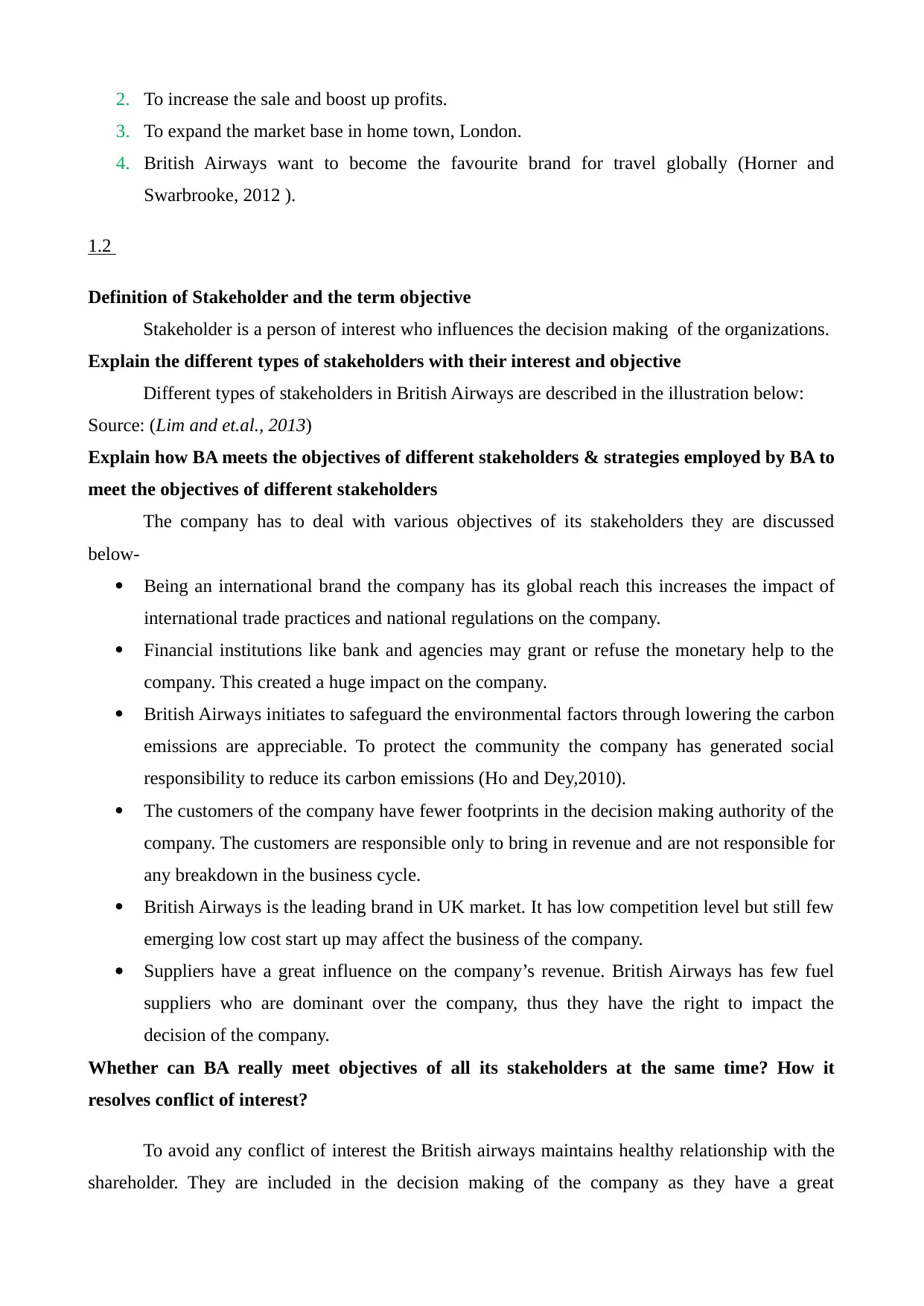
2. To increase the sale and boost up profits.
3. To expand the market base in home town, London.
4. British Airways want to become the favourite brand for travel globally (Horner and
Swarbrooke, 2012 ).
1.2
Definition of Stakeholder and the term objective
Stakeholder is a person of interest who influences the decision making of the organizations.
Explain the different types of stakeholders with their interest and objective
Different types of stakeholders in British Airways are described in the illustration below:
Source: (Lim and et.al., 2013)
Explain how BA meets the objectives of different stakeholders & strategies employed by BA to
meet the objectives of different stakeholders
The company has to deal with various objectives of its stakeholders they are discussed
below-
Being an international brand the company has its global reach this increases the impact of
international trade practices and national regulations on the company.
Financial institutions like bank and agencies may grant or refuse the monetary help to the
company. This created a huge impact on the company.
British Airways initiates to safeguard the environmental factors through lowering the carbon
emissions are appreciable. To protect the community the company has generated social
responsibility to reduce its carbon emissions (Ho and Dey,2010).
The customers of the company have fewer footprints in the decision making authority of the
company. The customers are responsible only to bring in revenue and are not responsible for
any breakdown in the business cycle.
British Airways is the leading brand in UK market. It has low competition level but still few
emerging low cost start up may affect the business of the company.
Suppliers have a great influence on the company’s revenue. British Airways has few fuel
suppliers who are dominant over the company, thus they have the right to impact the
decision of the company.
Whether can BA really meet objectives of all its stakeholders at the same time? How it
resolves conflict of interest?
To avoid any conflict of interest the British airways maintains healthy relationship with the
shareholder. They are included in the decision making of the company as they have a great
3. To expand the market base in home town, London.
4. British Airways want to become the favourite brand for travel globally (Horner and
Swarbrooke, 2012 ).
1.2
Definition of Stakeholder and the term objective
Stakeholder is a person of interest who influences the decision making of the organizations.
Explain the different types of stakeholders with their interest and objective
Different types of stakeholders in British Airways are described in the illustration below:
Source: (Lim and et.al., 2013)
Explain how BA meets the objectives of different stakeholders & strategies employed by BA to
meet the objectives of different stakeholders
The company has to deal with various objectives of its stakeholders they are discussed
below-
Being an international brand the company has its global reach this increases the impact of
international trade practices and national regulations on the company.
Financial institutions like bank and agencies may grant or refuse the monetary help to the
company. This created a huge impact on the company.
British Airways initiates to safeguard the environmental factors through lowering the carbon
emissions are appreciable. To protect the community the company has generated social
responsibility to reduce its carbon emissions (Ho and Dey,2010).
The customers of the company have fewer footprints in the decision making authority of the
company. The customers are responsible only to bring in revenue and are not responsible for
any breakdown in the business cycle.
British Airways is the leading brand in UK market. It has low competition level but still few
emerging low cost start up may affect the business of the company.
Suppliers have a great influence on the company’s revenue. British Airways has few fuel
suppliers who are dominant over the company, thus they have the right to impact the
decision of the company.
Whether can BA really meet objectives of all its stakeholders at the same time? How it
resolves conflict of interest?
To avoid any conflict of interest the British airways maintains healthy relationship with the
shareholder. They are included in the decision making of the company as they have a great
Secure Best Marks with AI Grader
Need help grading? Try our AI Grader for instant feedback on your assignments.
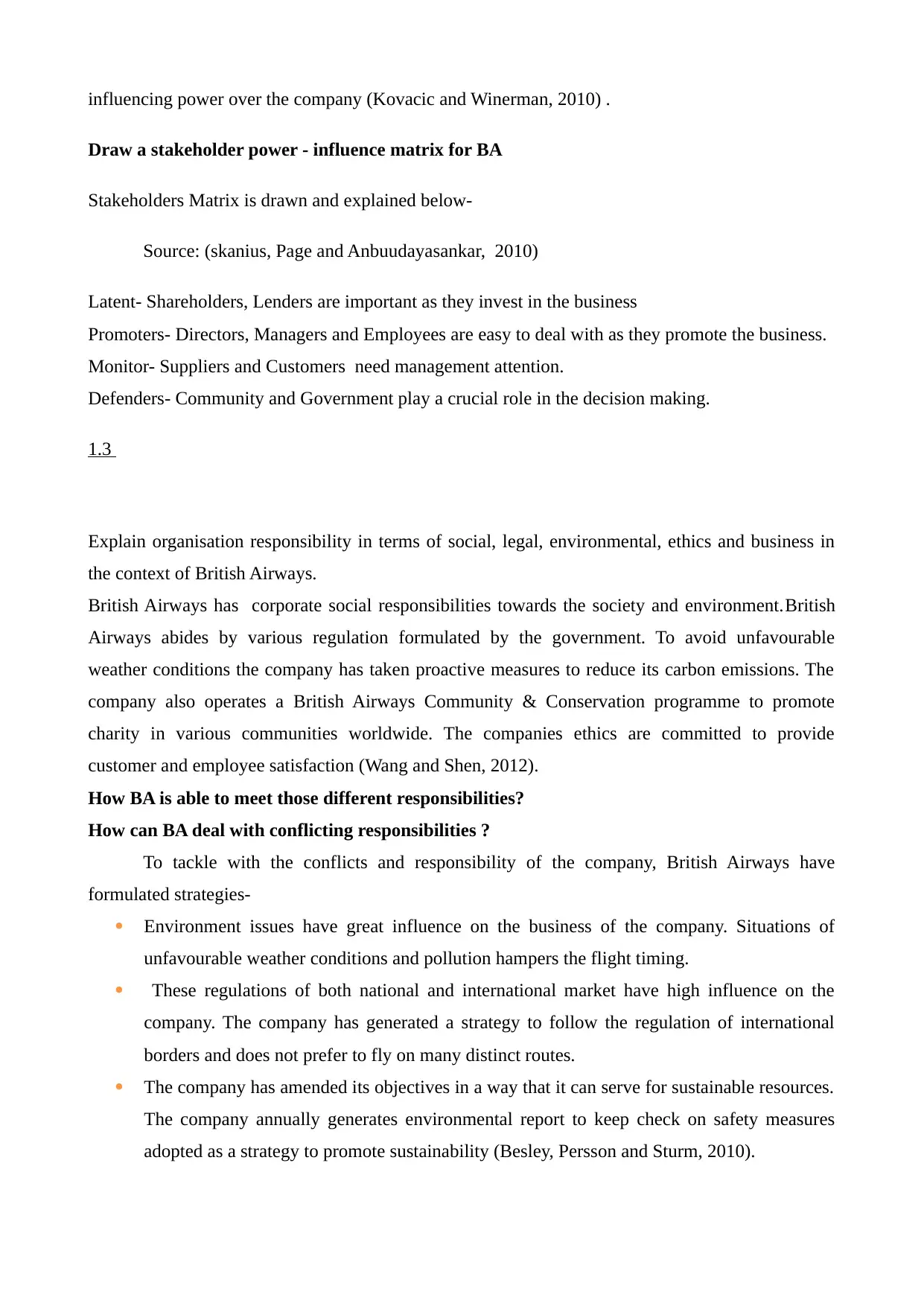
influencing power over the company (Kovacic and Winerman, 2010) .
Draw a stakeholder power - influence matrix for BA
Stakeholders Matrix is drawn and explained below-
Source: (skanius, Page and Anbuudayasankar, 2010)
Latent- Shareholders, Lenders are important as they invest in the business
Promoters- Directors, Managers and Employees are easy to deal with as they promote the business.
Monitor- Suppliers and Customers need management attention.
Defenders- Community and Government play a crucial role in the decision making.
1.3
Explain organisation responsibility in terms of social, legal, environmental, ethics and business in
the context of British Airways.
British Airways has corporate social responsibilities towards the society and environment.British
Airways abides by various regulation formulated by the government. To avoid unfavourable
weather conditions the company has taken proactive measures to reduce its carbon emissions. The
company also operates a British Airways Community & Conservation programme to promote
charity in various communities worldwide. The companies ethics are committed to provide
customer and employee satisfaction (Wang and Shen, 2012).
How BA is able to meet those different responsibilities?
How can BA deal with conflicting responsibilities ?
To tackle with the conflicts and responsibility of the company, British Airways have
formulated strategies-
Environment issues have great influence on the business of the company. Situations of
unfavourable weather conditions and pollution hampers the flight timing.
These regulations of both national and international market have high influence on the
company. The company has generated a strategy to follow the regulation of international
borders and does not prefer to fly on many distinct routes.
The company has amended its objectives in a way that it can serve for sustainable resources.
The company annually generates environmental report to keep check on safety measures
adopted as a strategy to promote sustainability (Besley, Persson and Sturm, 2010).
Draw a stakeholder power - influence matrix for BA
Stakeholders Matrix is drawn and explained below-
Source: (skanius, Page and Anbuudayasankar, 2010)
Latent- Shareholders, Lenders are important as they invest in the business
Promoters- Directors, Managers and Employees are easy to deal with as they promote the business.
Monitor- Suppliers and Customers need management attention.
Defenders- Community and Government play a crucial role in the decision making.
1.3
Explain organisation responsibility in terms of social, legal, environmental, ethics and business in
the context of British Airways.
British Airways has corporate social responsibilities towards the society and environment.British
Airways abides by various regulation formulated by the government. To avoid unfavourable
weather conditions the company has taken proactive measures to reduce its carbon emissions. The
company also operates a British Airways Community & Conservation programme to promote
charity in various communities worldwide. The companies ethics are committed to provide
customer and employee satisfaction (Wang and Shen, 2012).
How BA is able to meet those different responsibilities?
How can BA deal with conflicting responsibilities ?
To tackle with the conflicts and responsibility of the company, British Airways have
formulated strategies-
Environment issues have great influence on the business of the company. Situations of
unfavourable weather conditions and pollution hampers the flight timing.
These regulations of both national and international market have high influence on the
company. The company has generated a strategy to follow the regulation of international
borders and does not prefer to fly on many distinct routes.
The company has amended its objectives in a way that it can serve for sustainable resources.
The company annually generates environmental report to keep check on safety measures
adopted as a strategy to promote sustainability (Besley, Persson and Sturm, 2010).
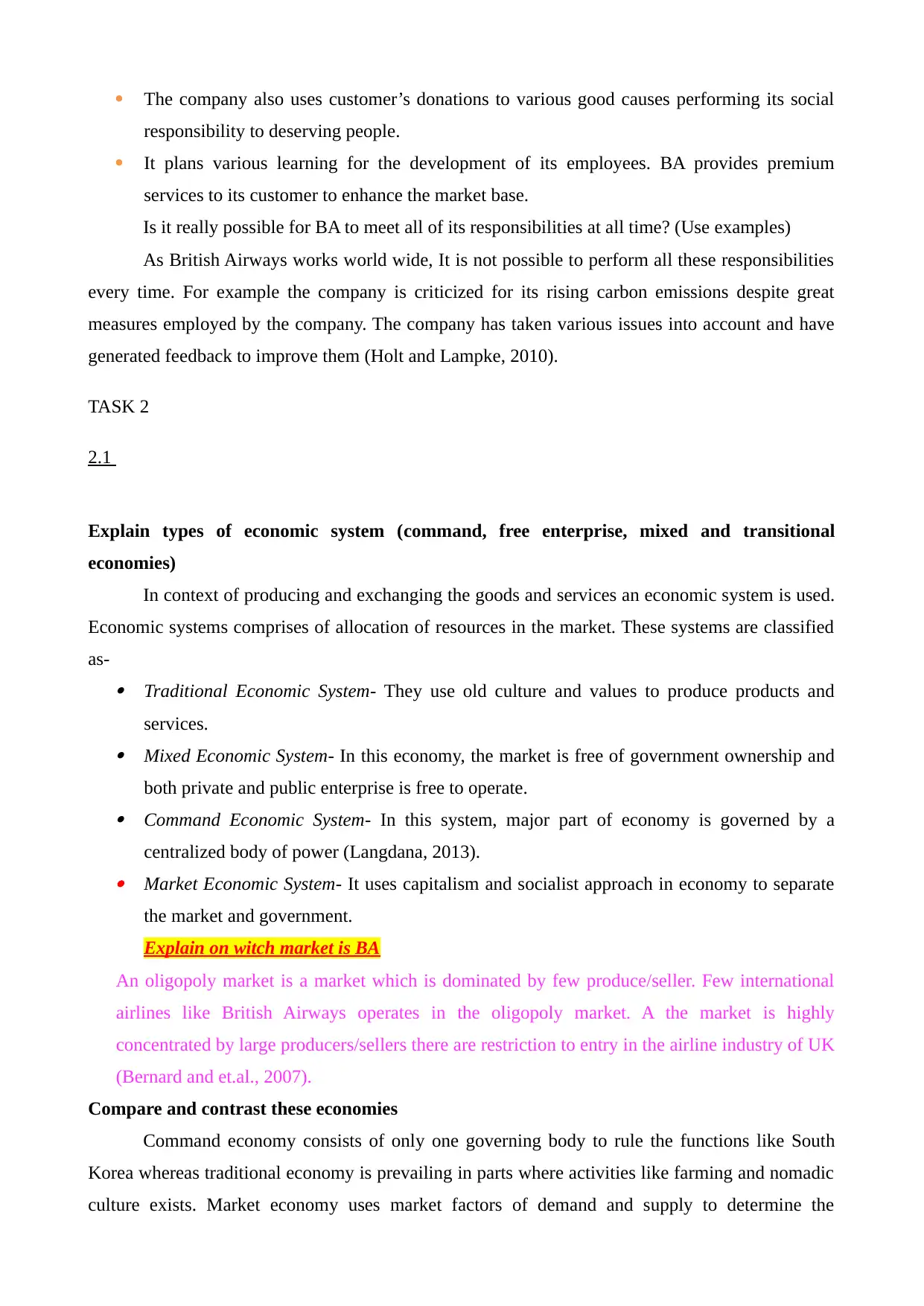
The company also uses customer’s donations to various good causes performing its social
responsibility to deserving people.
It plans various learning for the development of its employees. BA provides premium
services to its customer to enhance the market base.
Is it really possible for BA to meet all of its responsibilities at all time? (Use examples)
As British Airways works world wide, It is not possible to perform all these responsibilities
every time. For example the company is criticized for its rising carbon emissions despite great
measures employed by the company. The company has taken various issues into account and have
generated feedback to improve them (Holt and Lampke, 2010).
TASK 2
2.1
Explain types of economic system (command, free enterprise, mixed and transitional
economies)
In context of producing and exchanging the goods and services an economic system is used.
Economic systems comprises of allocation of resources in the market. These systems are classified
as- Traditional Economic System- They use old culture and values to produce products and
services. Mixed Economic System- In this economy, the market is free of government ownership and
both private and public enterprise is free to operate. Command Economic System- In this system, major part of economy is governed by a
centralized body of power (Langdana, 2013). Market Economic System- It uses capitalism and socialist approach in economy to separate
the market and government.
Explain on witch market is BA
An oligopoly market is a market which is dominated by few produce/seller. Few international
airlines like British Airways operates in the oligopoly market. A the market is highly
concentrated by large producers/sellers there are restriction to entry in the airline industry of UK
(Bernard and et.al., 2007).
Compare and contrast these economies
Command economy consists of only one governing body to rule the functions like South
Korea whereas traditional economy is prevailing in parts where activities like farming and nomadic
culture exists. Market economy uses market factors of demand and supply to determine the
responsibility to deserving people.
It plans various learning for the development of its employees. BA provides premium
services to its customer to enhance the market base.
Is it really possible for BA to meet all of its responsibilities at all time? (Use examples)
As British Airways works world wide, It is not possible to perform all these responsibilities
every time. For example the company is criticized for its rising carbon emissions despite great
measures employed by the company. The company has taken various issues into account and have
generated feedback to improve them (Holt and Lampke, 2010).
TASK 2
2.1
Explain types of economic system (command, free enterprise, mixed and transitional
economies)
In context of producing and exchanging the goods and services an economic system is used.
Economic systems comprises of allocation of resources in the market. These systems are classified
as- Traditional Economic System- They use old culture and values to produce products and
services. Mixed Economic System- In this economy, the market is free of government ownership and
both private and public enterprise is free to operate. Command Economic System- In this system, major part of economy is governed by a
centralized body of power (Langdana, 2013). Market Economic System- It uses capitalism and socialist approach in economy to separate
the market and government.
Explain on witch market is BA
An oligopoly market is a market which is dominated by few produce/seller. Few international
airlines like British Airways operates in the oligopoly market. A the market is highly
concentrated by large producers/sellers there are restriction to entry in the airline industry of UK
(Bernard and et.al., 2007).
Compare and contrast these economies
Command economy consists of only one governing body to rule the functions like South
Korea whereas traditional economy is prevailing in parts where activities like farming and nomadic
culture exists. Market economy uses market factors of demand and supply to determine the
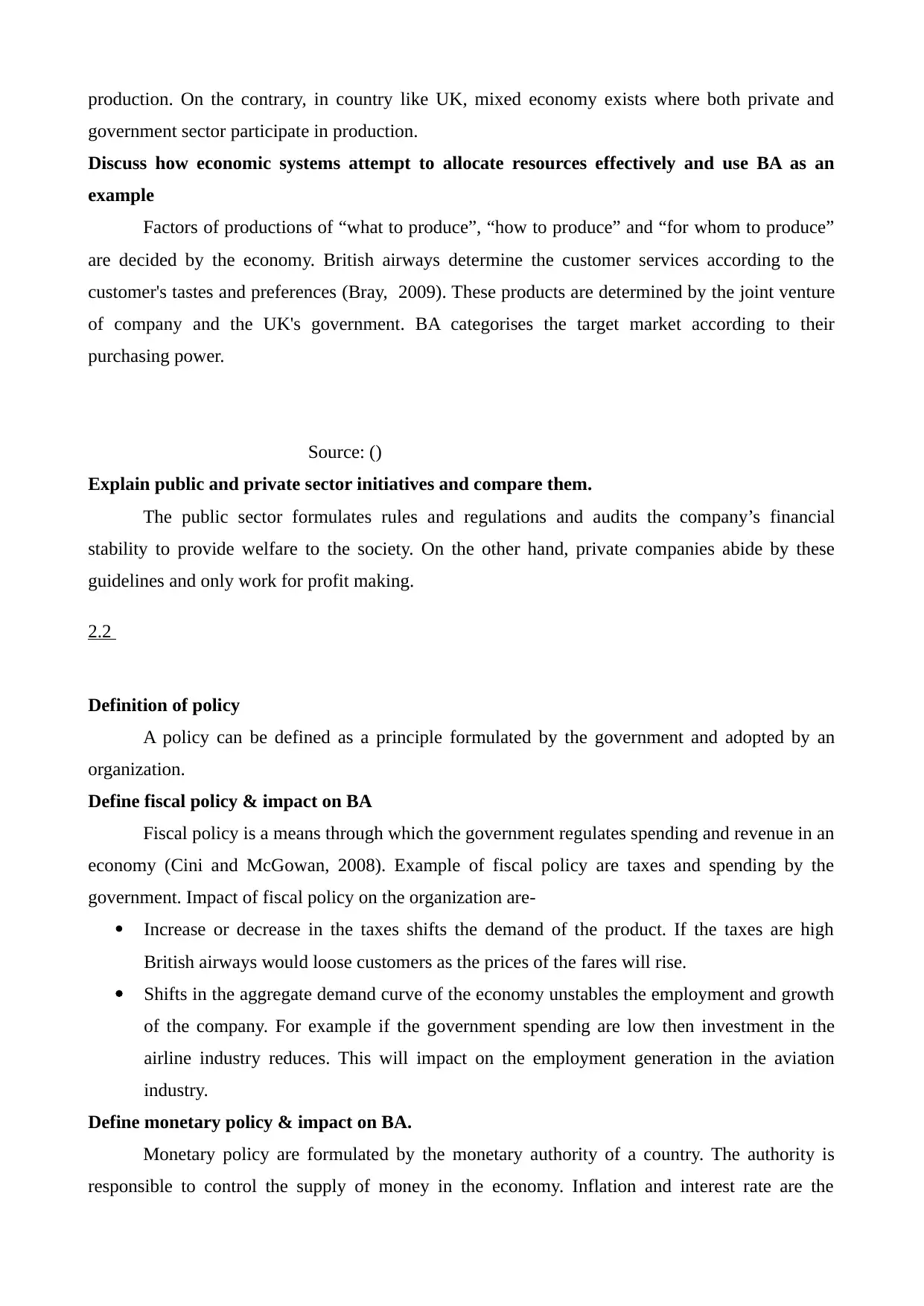
production. On the contrary, in country like UK, mixed economy exists where both private and
government sector participate in production.
Discuss how economic systems attempt to allocate resources effectively and use BA as an
example
Factors of productions of “what to produce”, “how to produce” and “for whom to produce”
are decided by the economy. British airways determine the customer services according to the
customer's tastes and preferences (Bray, 2009). These products are determined by the joint venture
of company and the UK's government. BA categorises the target market according to their
purchasing power.
Source: ()
Explain public and private sector initiatives and compare them.
The public sector formulates rules and regulations and audits the company’s financial
stability to provide welfare to the society. On the other hand, private companies abide by these
guidelines and only work for profit making.
2.2
Definition of policy
A policy can be defined as a principle formulated by the government and adopted by an
organization.
Define fiscal policy & impact on BA
Fiscal policy is a means through which the government regulates spending and revenue in an
economy (Cini and McGowan, 2008). Example of fiscal policy are taxes and spending by the
government. Impact of fiscal policy on the organization are-
Increase or decrease in the taxes shifts the demand of the product. If the taxes are high
British airways would loose customers as the prices of the fares will rise.
Shifts in the aggregate demand curve of the economy unstables the employment and growth
of the company. For example if the government spending are low then investment in the
airline industry reduces. This will impact on the employment generation in the aviation
industry.
Define monetary policy & impact on BA.
Monetary policy are formulated by the monetary authority of a country. The authority is
responsible to control the supply of money in the economy. Inflation and interest rate are the
government sector participate in production.
Discuss how economic systems attempt to allocate resources effectively and use BA as an
example
Factors of productions of “what to produce”, “how to produce” and “for whom to produce”
are decided by the economy. British airways determine the customer services according to the
customer's tastes and preferences (Bray, 2009). These products are determined by the joint venture
of company and the UK's government. BA categorises the target market according to their
purchasing power.
Source: ()
Explain public and private sector initiatives and compare them.
The public sector formulates rules and regulations and audits the company’s financial
stability to provide welfare to the society. On the other hand, private companies abide by these
guidelines and only work for profit making.
2.2
Definition of policy
A policy can be defined as a principle formulated by the government and adopted by an
organization.
Define fiscal policy & impact on BA
Fiscal policy is a means through which the government regulates spending and revenue in an
economy (Cini and McGowan, 2008). Example of fiscal policy are taxes and spending by the
government. Impact of fiscal policy on the organization are-
Increase or decrease in the taxes shifts the demand of the product. If the taxes are high
British airways would loose customers as the prices of the fares will rise.
Shifts in the aggregate demand curve of the economy unstables the employment and growth
of the company. For example if the government spending are low then investment in the
airline industry reduces. This will impact on the employment generation in the aviation
industry.
Define monetary policy & impact on BA.
Monetary policy are formulated by the monetary authority of a country. The authority is
responsible to control the supply of money in the economy. Inflation and interest rate are the
Paraphrase This Document
Need a fresh take? Get an instant paraphrase of this document with our AI Paraphraser
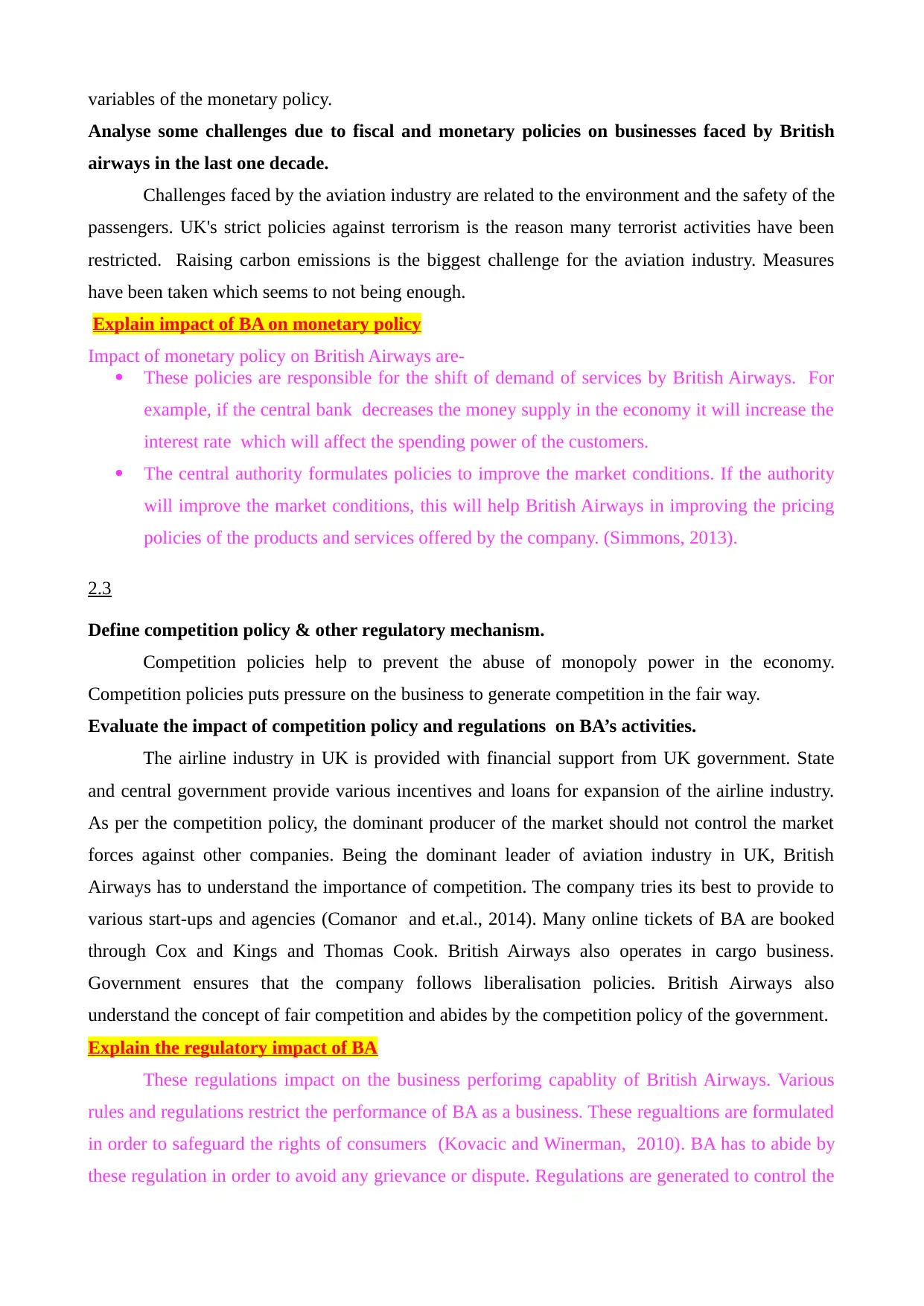
variables of the monetary policy.
Analyse some challenges due to fiscal and monetary policies on businesses faced by British
airways in the last one decade.
Challenges faced by the aviation industry are related to the environment and the safety of the
passengers. UK's strict policies against terrorism is the reason many terrorist activities have been
restricted. Raising carbon emissions is the biggest challenge for the aviation industry. Measures
have been taken which seems to not being enough.
Explain impact of BA on monetary policy
Impact of monetary policy on British Airways are-
These policies are responsible for the shift of demand of services by British Airways. For
example, if the central bank decreases the money supply in the economy it will increase the
interest rate which will affect the spending power of the customers.
The central authority formulates policies to improve the market conditions. If the authority
will improve the market conditions, this will help British Airways in improving the pricing
policies of the products and services offered by the company. (Simmons, 2013).
2.3
Define competition policy & other regulatory mechanism.
Competition policies help to prevent the abuse of monopoly power in the economy.
Competition policies puts pressure on the business to generate competition in the fair way.
Evaluate the impact of competition policy and regulations on BA’s activities.
The airline industry in UK is provided with financial support from UK government. State
and central government provide various incentives and loans for expansion of the airline industry.
As per the competition policy, the dominant producer of the market should not control the market
forces against other companies. Being the dominant leader of aviation industry in UK, British
Airways has to understand the importance of competition. The company tries its best to provide to
various start-ups and agencies (Comanor and et.al., 2014). Many online tickets of BA are booked
through Cox and Kings and Thomas Cook. British Airways also operates in cargo business.
Government ensures that the company follows liberalisation policies. British Airways also
understand the concept of fair competition and abides by the competition policy of the government.
Explain the regulatory impact of BA
These regulations impact on the business perforimg capablity of British Airways. Various
rules and regulations restrict the performance of BA as a business. These regualtions are formulated
in order to safeguard the rights of consumers (Kovacic and Winerman, 2010). BA has to abide by
these regulation in order to avoid any grievance or dispute. Regulations are generated to control the
Analyse some challenges due to fiscal and monetary policies on businesses faced by British
airways in the last one decade.
Challenges faced by the aviation industry are related to the environment and the safety of the
passengers. UK's strict policies against terrorism is the reason many terrorist activities have been
restricted. Raising carbon emissions is the biggest challenge for the aviation industry. Measures
have been taken which seems to not being enough.
Explain impact of BA on monetary policy
Impact of monetary policy on British Airways are-
These policies are responsible for the shift of demand of services by British Airways. For
example, if the central bank decreases the money supply in the economy it will increase the
interest rate which will affect the spending power of the customers.
The central authority formulates policies to improve the market conditions. If the authority
will improve the market conditions, this will help British Airways in improving the pricing
policies of the products and services offered by the company. (Simmons, 2013).
2.3
Define competition policy & other regulatory mechanism.
Competition policies help to prevent the abuse of monopoly power in the economy.
Competition policies puts pressure on the business to generate competition in the fair way.
Evaluate the impact of competition policy and regulations on BA’s activities.
The airline industry in UK is provided with financial support from UK government. State
and central government provide various incentives and loans for expansion of the airline industry.
As per the competition policy, the dominant producer of the market should not control the market
forces against other companies. Being the dominant leader of aviation industry in UK, British
Airways has to understand the importance of competition. The company tries its best to provide to
various start-ups and agencies (Comanor and et.al., 2014). Many online tickets of BA are booked
through Cox and Kings and Thomas Cook. British Airways also operates in cargo business.
Government ensures that the company follows liberalisation policies. British Airways also
understand the concept of fair competition and abides by the competition policy of the government.
Explain the regulatory impact of BA
These regulations impact on the business perforimg capablity of British Airways. Various
rules and regulations restrict the performance of BA as a business. These regualtions are formulated
in order to safeguard the rights of consumers (Kovacic and Winerman, 2010). BA has to abide by
these regulation in order to avoid any grievance or dispute. Regulations are generated to control the
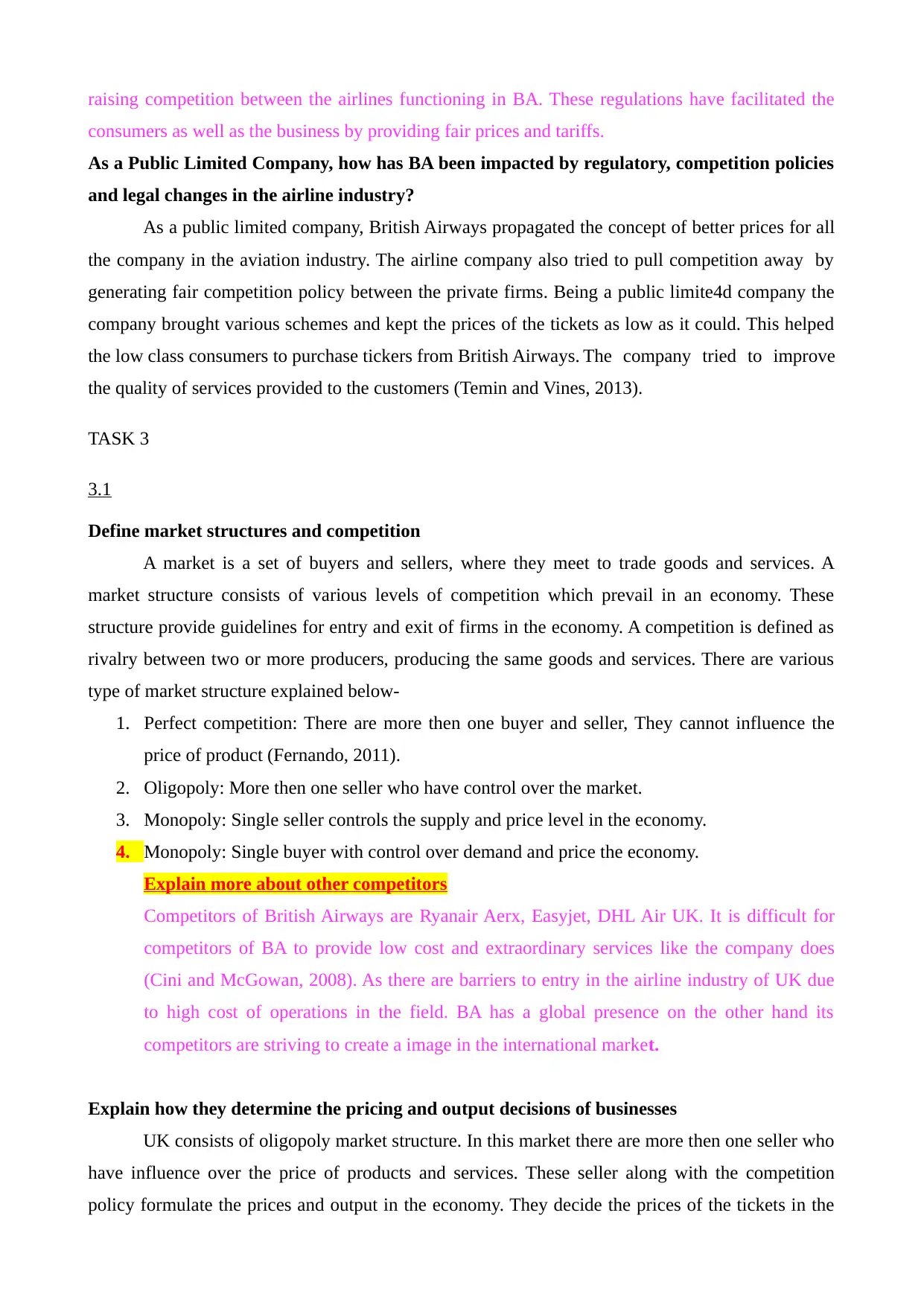
raising competition between the airlines functioning in BA. These regulations have facilitated the
consumers as well as the business by providing fair prices and tariffs.
As a Public Limited Company, how has BA been impacted by regulatory, competition policies
and legal changes in the airline industry?
As a public limited company, British Airways propagated the concept of better prices for all
the company in the aviation industry. The airline company also tried to pull competition away by
generating fair competition policy between the private firms. Being a public limite4d company the
company brought various schemes and kept the prices of the tickets as low as it could. This helped
the low class consumers to purchase tickers from British Airways. The company tried to improve
the quality of services provided to the customers (Temin and Vines, 2013).
TASK 3
3.1
Define market structures and competition
A market is a set of buyers and sellers, where they meet to trade goods and services. A
market structure consists of various levels of competition which prevail in an economy. These
structure provide guidelines for entry and exit of firms in the economy. A competition is defined as
rivalry between two or more producers, producing the same goods and services. There are various
type of market structure explained below-
1. Perfect competition: There are more then one buyer and seller, They cannot influence the
price of product (Fernando, 2011).
2. Oligopoly: More then one seller who have control over the market.
3. Monopoly: Single seller controls the supply and price level in the economy.
4. Monopoly: Single buyer with control over demand and price the economy.
Explain more about other competitors
Competitors of British Airways are Ryanair Aerx, Easyjet, DHL Air UK. It is difficult for
competitors of BA to provide low cost and extraordinary services like the company does
(Cini and McGowan, 2008). As there are barriers to entry in the airline industry of UK due
to high cost of operations in the field. BA has a global presence on the other hand its
competitors are striving to create a image in the international market.
Explain how they determine the pricing and output decisions of businesses
UK consists of oligopoly market structure. In this market there are more then one seller who
have influence over the price of products and services. These seller along with the competition
policy formulate the prices and output in the economy. They decide the prices of the tickets in the
consumers as well as the business by providing fair prices and tariffs.
As a Public Limited Company, how has BA been impacted by regulatory, competition policies
and legal changes in the airline industry?
As a public limited company, British Airways propagated the concept of better prices for all
the company in the aviation industry. The airline company also tried to pull competition away by
generating fair competition policy between the private firms. Being a public limite4d company the
company brought various schemes and kept the prices of the tickets as low as it could. This helped
the low class consumers to purchase tickers from British Airways. The company tried to improve
the quality of services provided to the customers (Temin and Vines, 2013).
TASK 3
3.1
Define market structures and competition
A market is a set of buyers and sellers, where they meet to trade goods and services. A
market structure consists of various levels of competition which prevail in an economy. These
structure provide guidelines for entry and exit of firms in the economy. A competition is defined as
rivalry between two or more producers, producing the same goods and services. There are various
type of market structure explained below-
1. Perfect competition: There are more then one buyer and seller, They cannot influence the
price of product (Fernando, 2011).
2. Oligopoly: More then one seller who have control over the market.
3. Monopoly: Single seller controls the supply and price level in the economy.
4. Monopoly: Single buyer with control over demand and price the economy.
Explain more about other competitors
Competitors of British Airways are Ryanair Aerx, Easyjet, DHL Air UK. It is difficult for
competitors of BA to provide low cost and extraordinary services like the company does
(Cini and McGowan, 2008). As there are barriers to entry in the airline industry of UK due
to high cost of operations in the field. BA has a global presence on the other hand its
competitors are striving to create a image in the international market.
Explain how they determine the pricing and output decisions of businesses
UK consists of oligopoly market structure. In this market there are more then one seller who
have influence over the price of products and services. These seller along with the competition
policy formulate the prices and output in the economy. They decide the prices of the tickets in the
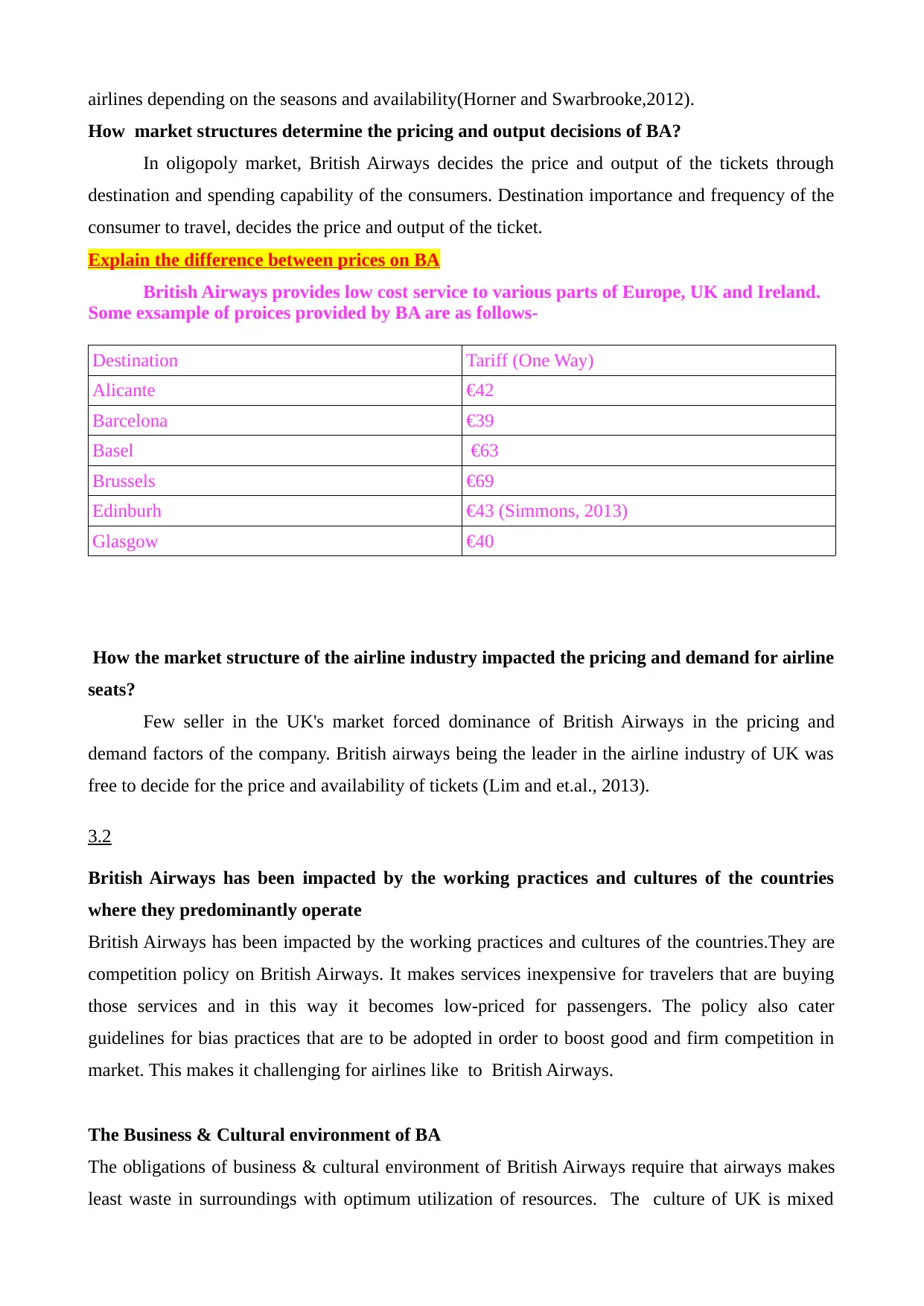
airlines depending on the seasons and availability(Horner and Swarbrooke,2012).
How market structures determine the pricing and output decisions of BA?
In oligopoly market, British Airways decides the price and output of the tickets through
destination and spending capability of the consumers. Destination importance and frequency of the
consumer to travel, decides the price and output of the ticket.
Explain the difference between prices on BA
British Airways provides low cost service to various parts of Europe, UK and Ireland.
Some exsample of proices provided by BA are as follows-
Destination Tariff (One Way)
Alicante €42
Barcelona €39
Basel €63
Brussels €69
Edinburh €43 (Simmons, 2013)
Glasgow €40
How the market structure of the airline industry impacted the pricing and demand for airline
seats?
Few seller in the UK's market forced dominance of British Airways in the pricing and
demand factors of the company. British airways being the leader in the airline industry of UK was
free to decide for the price and availability of tickets (Lim and et.al., 2013).
3.2
British Airways has been impacted by the working practices and cultures of the countries
where they predominantly operate
British Airways has been impacted by the working practices and cultures of the countries.They are
competition policy on British Airways. It makes services inexpensive for travelers that are buying
those services and in this way it becomes low-priced for passengers. The policy also cater
guidelines for bias practices that are to be adopted in order to boost good and firm competition in
market. This makes it challenging for airlines like to British Airways.
The Business & Cultural environment of BA
The obligations of business & cultural environment of British Airways require that airways makes
least waste in surroundings with optimum utilization of resources. The culture of UK is mixed
How market structures determine the pricing and output decisions of BA?
In oligopoly market, British Airways decides the price and output of the tickets through
destination and spending capability of the consumers. Destination importance and frequency of the
consumer to travel, decides the price and output of the ticket.
Explain the difference between prices on BA
British Airways provides low cost service to various parts of Europe, UK and Ireland.
Some exsample of proices provided by BA are as follows-
Destination Tariff (One Way)
Alicante €42
Barcelona €39
Basel €63
Brussels €69
Edinburh €43 (Simmons, 2013)
Glasgow €40
How the market structure of the airline industry impacted the pricing and demand for airline
seats?
Few seller in the UK's market forced dominance of British Airways in the pricing and
demand factors of the company. British airways being the leader in the airline industry of UK was
free to decide for the price and availability of tickets (Lim and et.al., 2013).
3.2
British Airways has been impacted by the working practices and cultures of the countries
where they predominantly operate
British Airways has been impacted by the working practices and cultures of the countries.They are
competition policy on British Airways. It makes services inexpensive for travelers that are buying
those services and in this way it becomes low-priced for passengers. The policy also cater
guidelines for bias practices that are to be adopted in order to boost good and firm competition in
market. This makes it challenging for airlines like to British Airways.
The Business & Cultural environment of BA
The obligations of business & cultural environment of British Airways require that airways makes
least waste in surroundings with optimum utilization of resources. The culture of UK is mixed
Secure Best Marks with AI Grader
Need help grading? Try our AI Grader for instant feedback on your assignments.
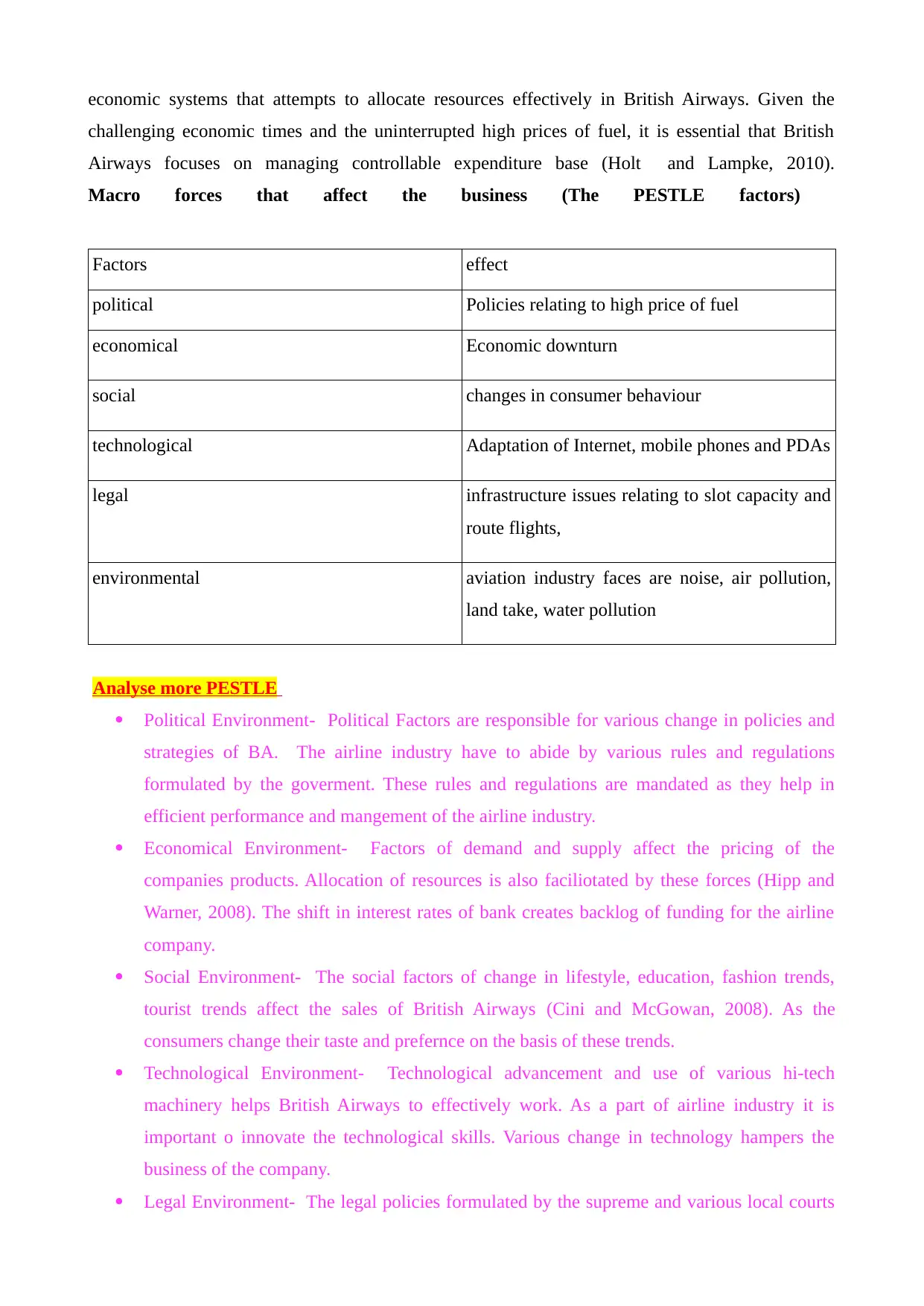
economic systems that attempts to allocate resources effectively in British Airways. Given the
challenging economic times and the uninterrupted high prices of fuel, it is essential that British
Airways focuses on managing controllable expenditure base (Holt and Lampke, 2010).
Macro forces that affect the business (The PESTLE factors)
Factors effect
political Policies relating to high price of fuel
economical Economic downturn
social changes in consumer behaviour
technological Adaptation of Internet, mobile phones and PDAs
legal infrastructure issues relating to slot capacity and
route flights,
environmental aviation industry faces are noise, air pollution,
land take, water pollution
Analyse more PESTLE
Political Environment- Political Factors are responsible for various change in policies and
strategies of BA. The airline industry have to abide by various rules and regulations
formulated by the goverment. These rules and regulations are mandated as they help in
efficient performance and mangement of the airline industry.
Economical Environment- Factors of demand and supply affect the pricing of the
companies products. Allocation of resources is also faciliotated by these forces (Hipp and
Warner, 2008). The shift in interest rates of bank creates backlog of funding for the airline
company.
Social Environment- The social factors of change in lifestyle, education, fashion trends,
tourist trends affect the sales of British Airways (Cini and McGowan, 2008). As the
consumers change their taste and prefernce on the basis of these trends.
Technological Environment- Technological advancement and use of various hi-tech
machinery helps British Airways to effectively work. As a part of airline industry it is
important o innovate the technological skills. Various change in technology hampers the
business of the company.
Legal Environment- The legal policies formulated by the supreme and various local courts
challenging economic times and the uninterrupted high prices of fuel, it is essential that British
Airways focuses on managing controllable expenditure base (Holt and Lampke, 2010).
Macro forces that affect the business (The PESTLE factors)
Factors effect
political Policies relating to high price of fuel
economical Economic downturn
social changes in consumer behaviour
technological Adaptation of Internet, mobile phones and PDAs
legal infrastructure issues relating to slot capacity and
route flights,
environmental aviation industry faces are noise, air pollution,
land take, water pollution
Analyse more PESTLE
Political Environment- Political Factors are responsible for various change in policies and
strategies of BA. The airline industry have to abide by various rules and regulations
formulated by the goverment. These rules and regulations are mandated as they help in
efficient performance and mangement of the airline industry.
Economical Environment- Factors of demand and supply affect the pricing of the
companies products. Allocation of resources is also faciliotated by these forces (Hipp and
Warner, 2008). The shift in interest rates of bank creates backlog of funding for the airline
company.
Social Environment- The social factors of change in lifestyle, education, fashion trends,
tourist trends affect the sales of British Airways (Cini and McGowan, 2008). As the
consumers change their taste and prefernce on the basis of these trends.
Technological Environment- Technological advancement and use of various hi-tech
machinery helps British Airways to effectively work. As a part of airline industry it is
important o innovate the technological skills. Various change in technology hampers the
business of the company.
Legal Environment- The legal policies formulated by the supreme and various local courts
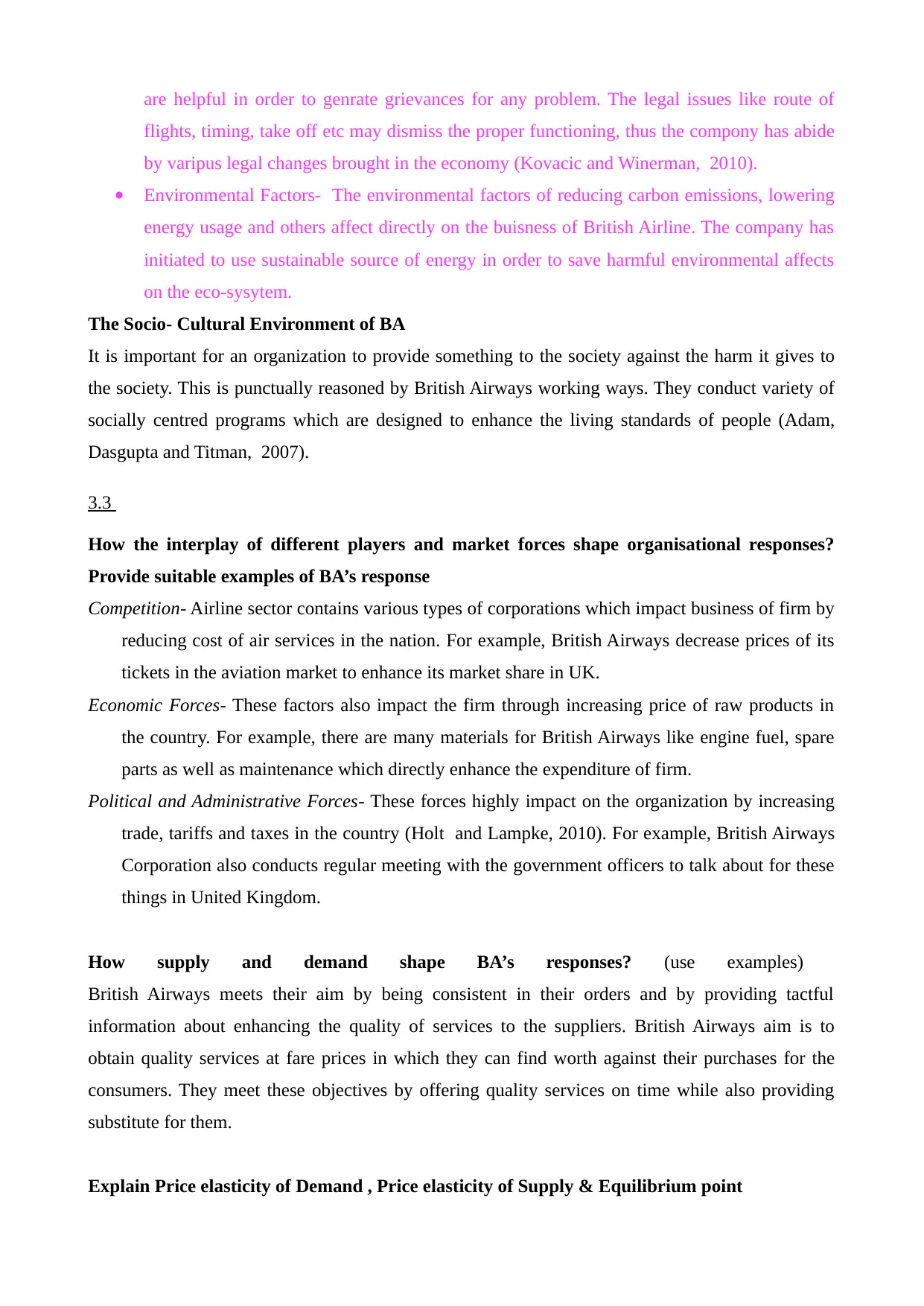
are helpful in order to genrate grievances for any problem. The legal issues like route of
flights, timing, take off etc may dismiss the proper functioning, thus the compony has abide
by varipus legal changes brought in the economy (Kovacic and Winerman, 2010).
Environmental Factors- The environmental factors of reducing carbon emissions, lowering
energy usage and others affect directly on the buisness of British Airline. The company has
initiated to use sustainable source of energy in order to save harmful environmental affects
on the eco-sysytem.
The Socio- Cultural Environment of BA
It is important for an organization to provide something to the society against the harm it gives to
the society. This is punctually reasoned by British Airways working ways. They conduct variety of
socially centred programs which are designed to enhance the living standards of people (Adam,
Dasgupta and Titman, 2007).
3.3
How the interplay of different players and market forces shape organisational responses?
Provide suitable examples of BA’s response
Competition- Airline sector contains various types of corporations which impact business of firm by
reducing cost of air services in the nation. For example, British Airways decrease prices of its
tickets in the aviation market to enhance its market share in UK.
Economic Forces- These factors also impact the firm through increasing price of raw products in
the country. For example, there are many materials for British Airways like engine fuel, spare
parts as well as maintenance which directly enhance the expenditure of firm.
Political and Administrative Forces- These forces highly impact on the organization by increasing
trade, tariffs and taxes in the country (Holt and Lampke, 2010). For example, British Airways
Corporation also conducts regular meeting with the government officers to talk about for these
things in United Kingdom.
How supply and demand shape BA’s responses? (use examples)
British Airways meets their aim by being consistent in their orders and by providing tactful
information about enhancing the quality of services to the suppliers. British Airways aim is to
obtain quality services at fare prices in which they can find worth against their purchases for the
consumers. They meet these objectives by offering quality services on time while also providing
substitute for them.
Explain Price elasticity of Demand , Price elasticity of Supply & Equilibrium point
flights, timing, take off etc may dismiss the proper functioning, thus the compony has abide
by varipus legal changes brought in the economy (Kovacic and Winerman, 2010).
Environmental Factors- The environmental factors of reducing carbon emissions, lowering
energy usage and others affect directly on the buisness of British Airline. The company has
initiated to use sustainable source of energy in order to save harmful environmental affects
on the eco-sysytem.
The Socio- Cultural Environment of BA
It is important for an organization to provide something to the society against the harm it gives to
the society. This is punctually reasoned by British Airways working ways. They conduct variety of
socially centred programs which are designed to enhance the living standards of people (Adam,
Dasgupta and Titman, 2007).
3.3
How the interplay of different players and market forces shape organisational responses?
Provide suitable examples of BA’s response
Competition- Airline sector contains various types of corporations which impact business of firm by
reducing cost of air services in the nation. For example, British Airways decrease prices of its
tickets in the aviation market to enhance its market share in UK.
Economic Forces- These factors also impact the firm through increasing price of raw products in
the country. For example, there are many materials for British Airways like engine fuel, spare
parts as well as maintenance which directly enhance the expenditure of firm.
Political and Administrative Forces- These forces highly impact on the organization by increasing
trade, tariffs and taxes in the country (Holt and Lampke, 2010). For example, British Airways
Corporation also conducts regular meeting with the government officers to talk about for these
things in United Kingdom.
How supply and demand shape BA’s responses? (use examples)
British Airways meets their aim by being consistent in their orders and by providing tactful
information about enhancing the quality of services to the suppliers. British Airways aim is to
obtain quality services at fare prices in which they can find worth against their purchases for the
consumers. They meet these objectives by offering quality services on time while also providing
substitute for them.
Explain Price elasticity of Demand , Price elasticity of Supply & Equilibrium point
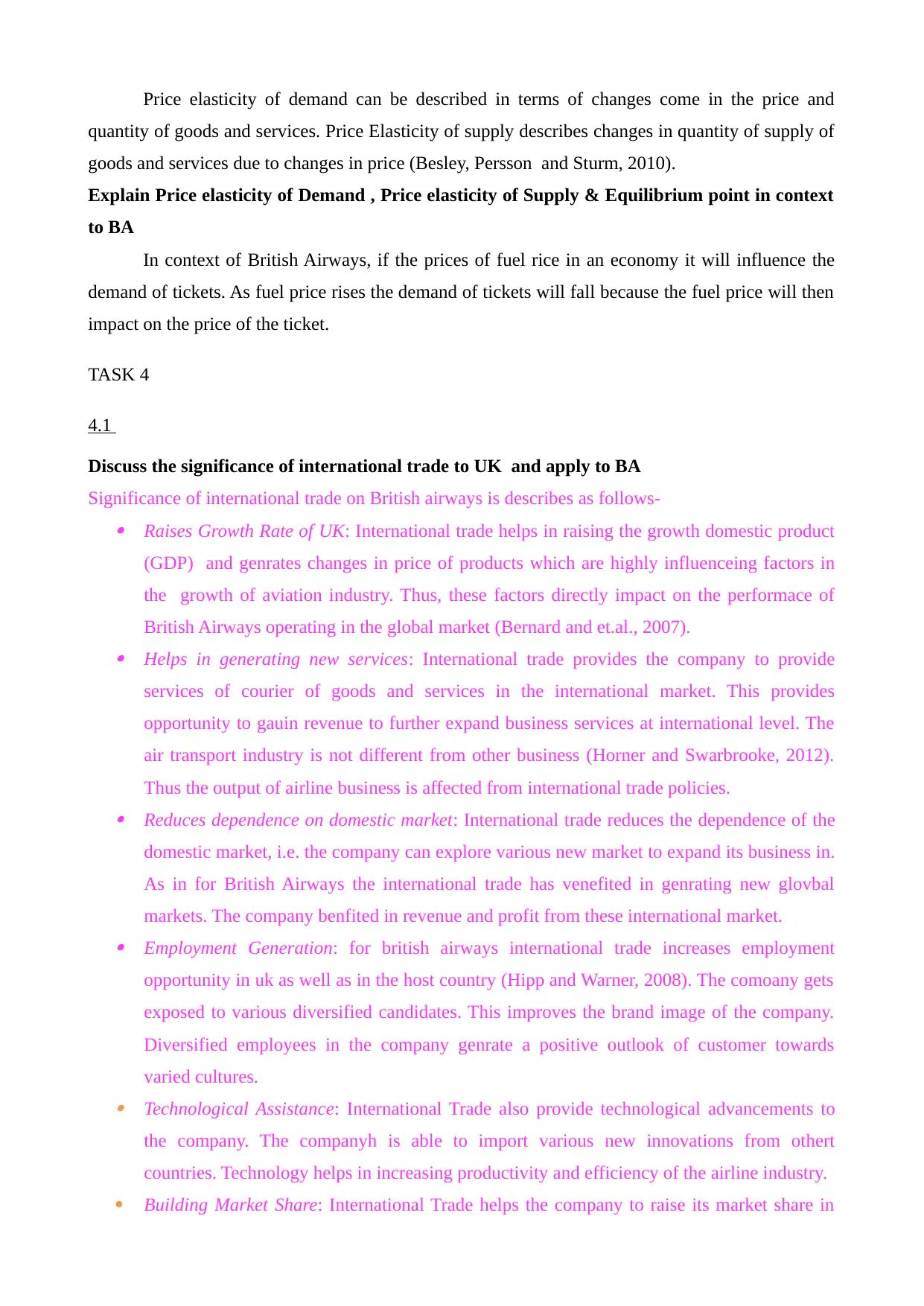
Price elasticity of demand can be described in terms of changes come in the price and
quantity of goods and services. Price Elasticity of supply describes changes in quantity of supply of
goods and services due to changes in price (Besley, Persson and Sturm, 2010).
Explain Price elasticity of Demand , Price elasticity of Supply & Equilibrium point in context
to BA
In context of British Airways, if the prices of fuel rice in an economy it will influence the
demand of tickets. As fuel price rises the demand of tickets will fall because the fuel price will then
impact on the price of the ticket.
TASK 4
4.1
Discuss the significance of international trade to UK and apply to BA
Significance of international trade on British airways is describes as follows- Raises Growth Rate of UK: International trade helps in raising the growth domestic product
(GDP) and genrates changes in price of products which are highly influenceing factors in
the growth of aviation industry. Thus, these factors directly impact on the performace of
British Airways operating in the global market (Bernard and et.al., 2007). Helps in generating new services: International trade provides the company to provide
services of courier of goods and services in the international market. This provides
opportunity to gauin revenue to further expand business services at international level. The
air transport industry is not different from other business (Horner and Swarbrooke, 2012).
Thus the output of airline business is affected from international trade policies. Reduces dependence on domestic market: International trade reduces the dependence of the
domestic market, i.e. the company can explore various new market to expand its business in.
As in for British Airways the international trade has venefited in genrating new glovbal
markets. The company benfited in revenue and profit from these international market. Employment Generation: for british airways international trade increases employment
opportunity in uk as well as in the host country (Hipp and Warner, 2008). The comoany gets
exposed to various diversified candidates. This improves the brand image of the company.
Diversified employees in the company genrate a positive outlook of customer towards
varied cultures. Technological Assistance: International Trade also provide technological advancements to
the company. The companyh is able to import various new innovations from othert
countries. Technology helps in increasing productivity and efficiency of the airline industry.
Building Market Share: International Trade helps the company to raise its market share in
quantity of goods and services. Price Elasticity of supply describes changes in quantity of supply of
goods and services due to changes in price (Besley, Persson and Sturm, 2010).
Explain Price elasticity of Demand , Price elasticity of Supply & Equilibrium point in context
to BA
In context of British Airways, if the prices of fuel rice in an economy it will influence the
demand of tickets. As fuel price rises the demand of tickets will fall because the fuel price will then
impact on the price of the ticket.
TASK 4
4.1
Discuss the significance of international trade to UK and apply to BA
Significance of international trade on British airways is describes as follows- Raises Growth Rate of UK: International trade helps in raising the growth domestic product
(GDP) and genrates changes in price of products which are highly influenceing factors in
the growth of aviation industry. Thus, these factors directly impact on the performace of
British Airways operating in the global market (Bernard and et.al., 2007). Helps in generating new services: International trade provides the company to provide
services of courier of goods and services in the international market. This provides
opportunity to gauin revenue to further expand business services at international level. The
air transport industry is not different from other business (Horner and Swarbrooke, 2012).
Thus the output of airline business is affected from international trade policies. Reduces dependence on domestic market: International trade reduces the dependence of the
domestic market, i.e. the company can explore various new market to expand its business in.
As in for British Airways the international trade has venefited in genrating new glovbal
markets. The company benfited in revenue and profit from these international market. Employment Generation: for british airways international trade increases employment
opportunity in uk as well as in the host country (Hipp and Warner, 2008). The comoany gets
exposed to various diversified candidates. This improves the brand image of the company.
Diversified employees in the company genrate a positive outlook of customer towards
varied cultures. Technological Assistance: International Trade also provide technological advancements to
the company. The companyh is able to import various new innovations from othert
countries. Technology helps in increasing productivity and efficiency of the airline industry.
Building Market Share: International Trade helps the company to raise its market share in
Paraphrase This Document
Need a fresh take? Get an instant paraphrase of this document with our AI Paraphraser
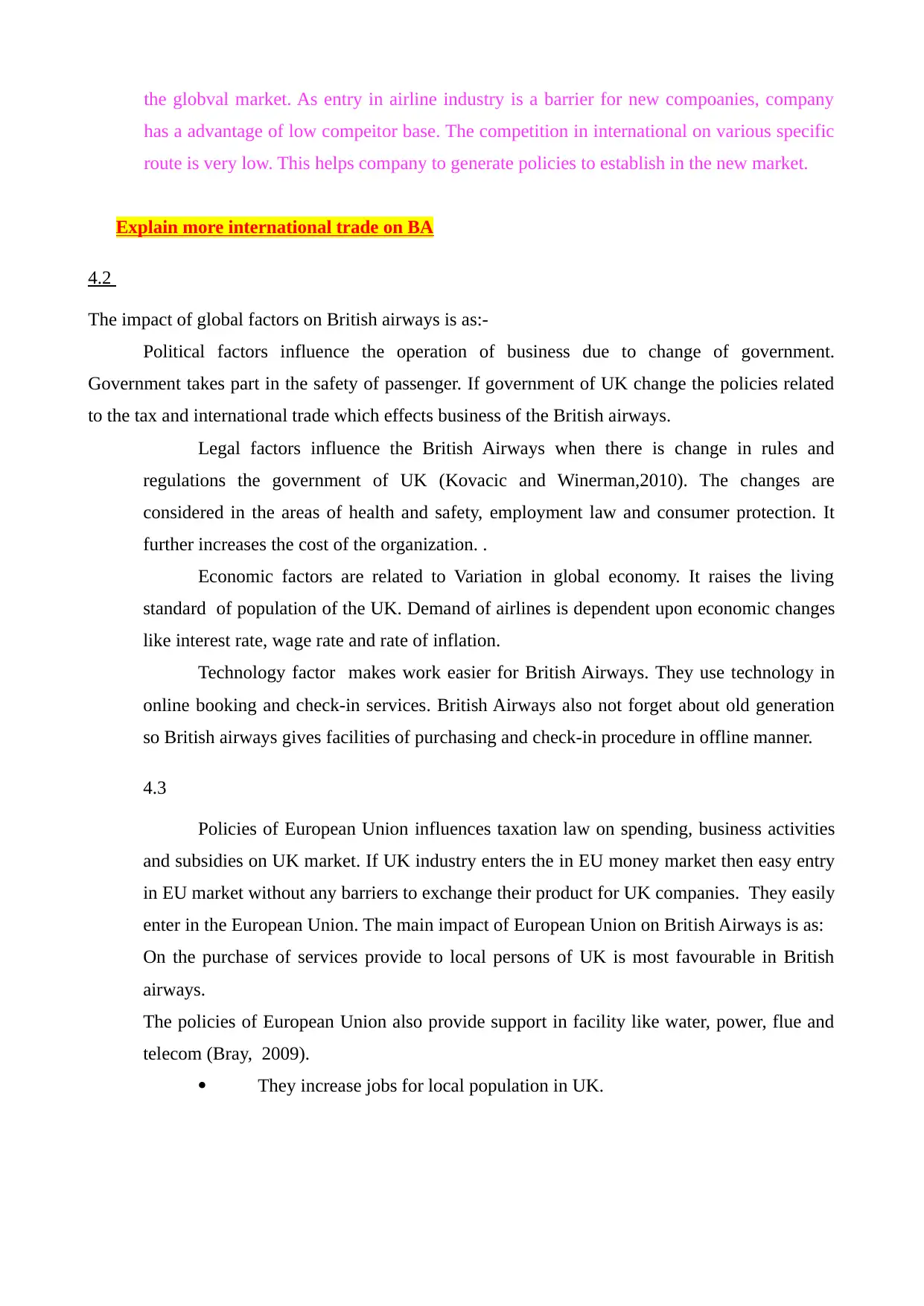
the globval market. As entry in airline industry is a barrier for new compoanies, company
has a advantage of low compeitor base. The competition in international on various specific
route is very low. This helps company to generate policies to establish in the new market.
Explain more international trade on BA
4.2
The impact of global factors on British airways is as:-
Political factors influence the operation of business due to change of government.
Government takes part in the safety of passenger. If government of UK change the policies related
to the tax and international trade which effects business of the British airways.
Legal factors influence the British Airways when there is change in rules and
regulations the government of UK (Kovacic and Winerman,2010). The changes are
considered in the areas of health and safety, employment law and consumer protection. It
further increases the cost of the organization. .
Economic factors are related to Variation in global economy. It raises the living
standard of population of the UK. Demand of airlines is dependent upon economic changes
like interest rate, wage rate and rate of inflation.
Technology factor makes work easier for British Airways. They use technology in
online booking and check-in services. British Airways also not forget about old generation
so British airways gives facilities of purchasing and check-in procedure in offline manner.
4.3
Policies of European Union influences taxation law on spending, business activities
and subsidies on UK market. If UK industry enters the in EU money market then easy entry
in EU market without any barriers to exchange their product for UK companies. They easily
enter in the European Union. The main impact of European Union on British Airways is as:
On the purchase of services provide to local persons of UK is most favourable in British
airways.
The policies of European Union also provide support in facility like water, power, flue and
telecom (Bray, 2009).
They increase jobs for local population in UK.
has a advantage of low compeitor base. The competition in international on various specific
route is very low. This helps company to generate policies to establish in the new market.
Explain more international trade on BA
4.2
The impact of global factors on British airways is as:-
Political factors influence the operation of business due to change of government.
Government takes part in the safety of passenger. If government of UK change the policies related
to the tax and international trade which effects business of the British airways.
Legal factors influence the British Airways when there is change in rules and
regulations the government of UK (Kovacic and Winerman,2010). The changes are
considered in the areas of health and safety, employment law and consumer protection. It
further increases the cost of the organization. .
Economic factors are related to Variation in global economy. It raises the living
standard of population of the UK. Demand of airlines is dependent upon economic changes
like interest rate, wage rate and rate of inflation.
Technology factor makes work easier for British Airways. They use technology in
online booking and check-in services. British Airways also not forget about old generation
so British airways gives facilities of purchasing and check-in procedure in offline manner.
4.3
Policies of European Union influences taxation law on spending, business activities
and subsidies on UK market. If UK industry enters the in EU money market then easy entry
in EU market without any barriers to exchange their product for UK companies. They easily
enter in the European Union. The main impact of European Union on British Airways is as:
On the purchase of services provide to local persons of UK is most favourable in British
airways.
The policies of European Union also provide support in facility like water, power, flue and
telecom (Bray, 2009).
They increase jobs for local population in UK.
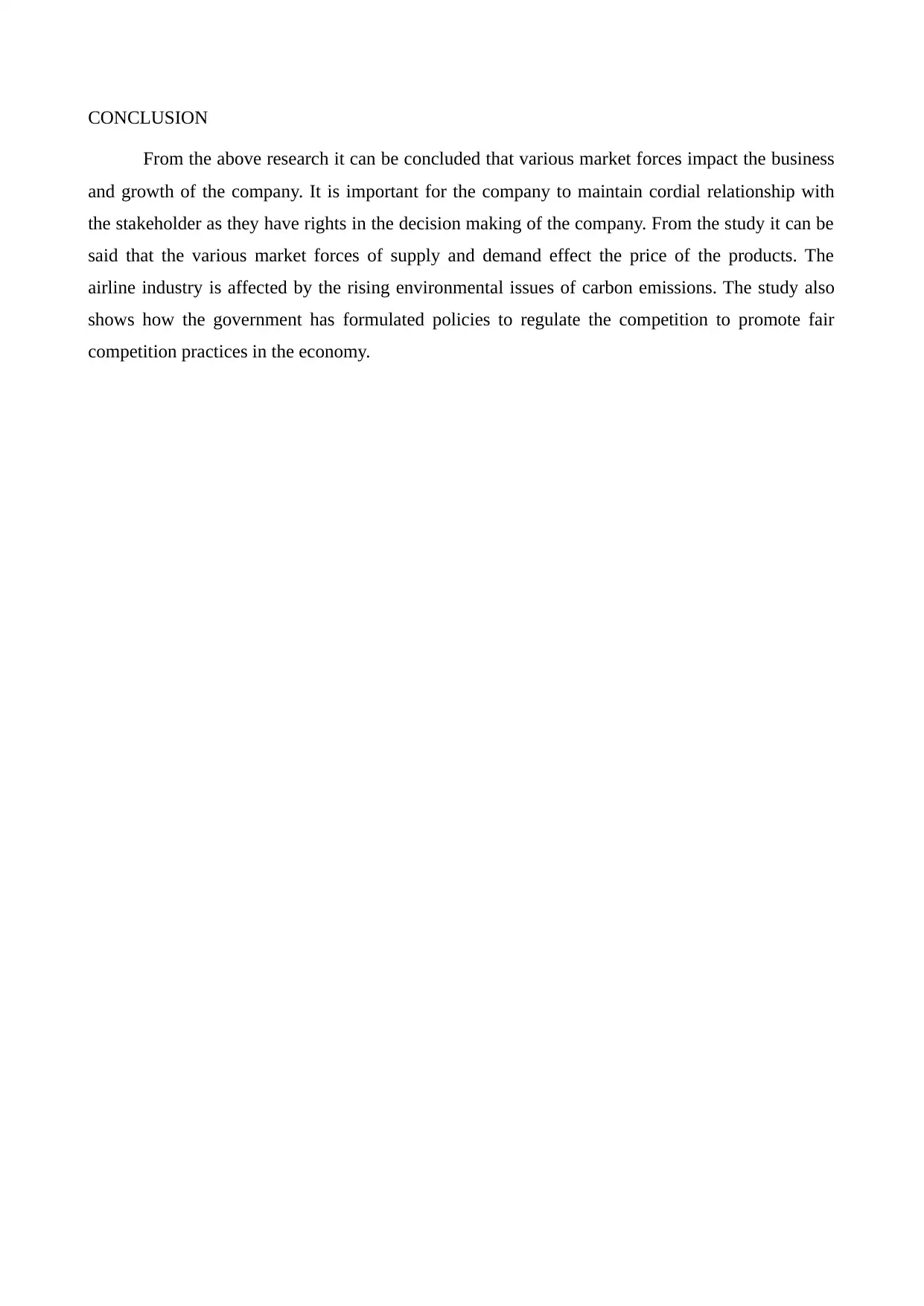
CONCLUSION
From the above research it can be concluded that various market forces impact the business
and growth of the company. It is important for the company to maintain cordial relationship with
the stakeholder as they have rights in the decision making of the company. From the study it can be
said that the various market forces of supply and demand effect the price of the products. The
airline industry is affected by the rising environmental issues of carbon emissions. The study also
shows how the government has formulated policies to regulate the competition to promote fair
competition practices in the economy.
From the above research it can be concluded that various market forces impact the business
and growth of the company. It is important for the company to maintain cordial relationship with
the stakeholder as they have rights in the decision making of the company. From the study it can be
said that the various market forces of supply and demand effect the price of the products. The
airline industry is affected by the rising environmental issues of carbon emissions. The study also
shows how the government has formulated policies to regulate the competition to promote fair
competition practices in the economy.
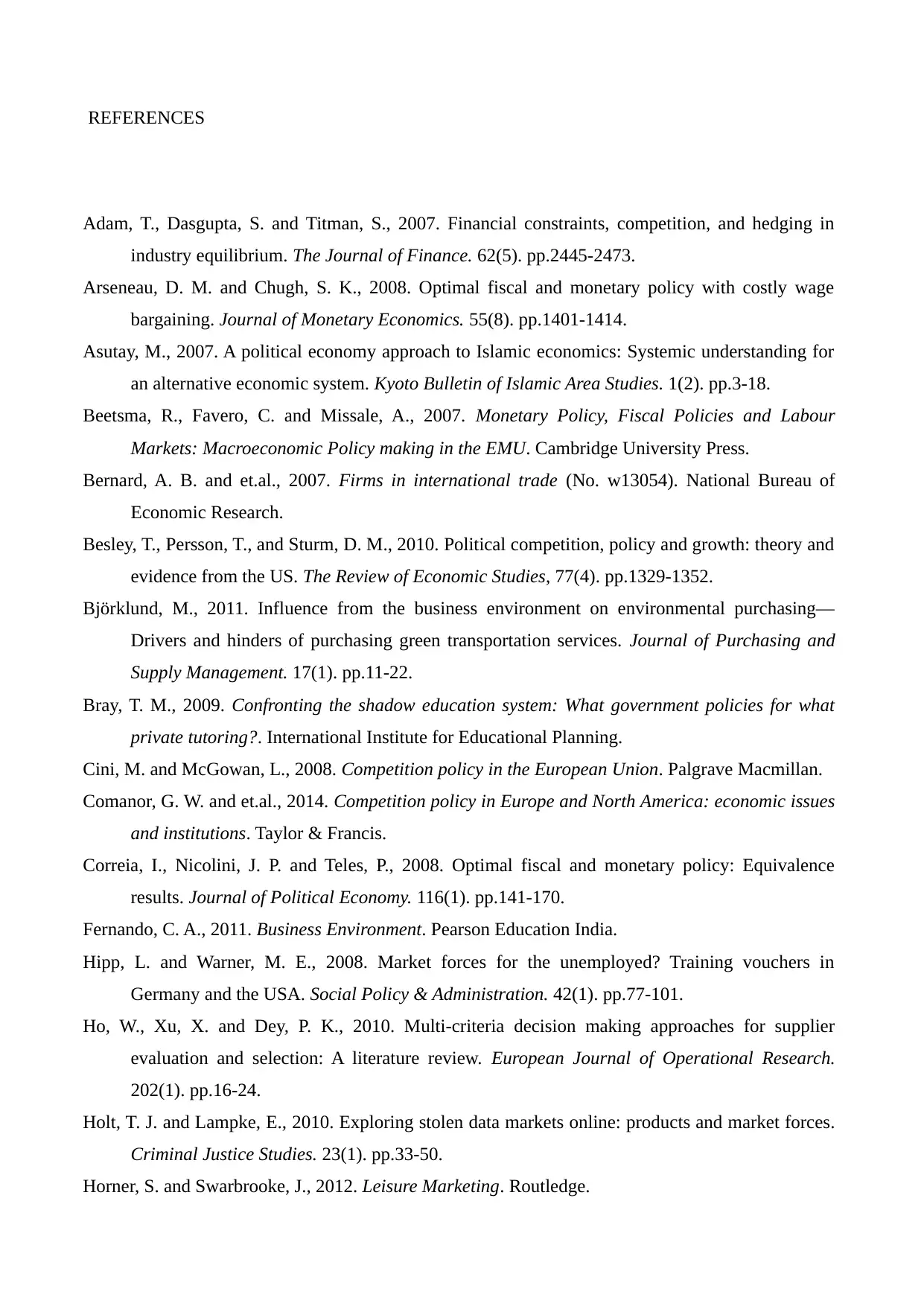
REFERENCES
Adam, T., Dasgupta, S. and Titman, S., 2007. Financial constraints, competition, and hedging in
industry equilibrium. The Journal of Finance. 62(5). pp.2445-2473.
Arseneau, D. M. and Chugh, S. K., 2008. Optimal fiscal and monetary policy with costly wage
bargaining. Journal of Monetary Economics. 55(8). pp.1401-1414.
Asutay, M., 2007. A political economy approach to Islamic economics: Systemic understanding for
an alternative economic system. Kyoto Bulletin of Islamic Area Studies. 1(2). pp.3-18.
Beetsma, R., Favero, C. and Missale, A., 2007. Monetary Policy, Fiscal Policies and Labour
Markets: Macroeconomic Policy making in the EMU. Cambridge University Press.
Bernard, A. B. and et.al., 2007. Firms in international trade (No. w13054). National Bureau of
Economic Research.
Besley, T., Persson, T., and Sturm, D. M., 2010. Political competition, policy and growth: theory and
evidence from the US. The Review of Economic Studies, 77(4). pp.1329-1352.
Björklund, M., 2011. Influence from the business environment on environmental purchasing—
Drivers and hinders of purchasing green transportation services. Journal of Purchasing and
Supply Management. 17(1). pp.11-22.
Bray, T. M., 2009. Confronting the shadow education system: What government policies for what
private tutoring?. International Institute for Educational Planning.
Cini, M. and McGowan, L., 2008. Competition policy in the European Union. Palgrave Macmillan.
Comanor, G. W. and et.al., 2014. Competition policy in Europe and North America: economic issues
and institutions. Taylor & Francis.
Correia, I., Nicolini, J. P. and Teles, P., 2008. Optimal fiscal and monetary policy: Equivalence
results. Journal of Political Economy. 116(1). pp.141-170.
Fernando, C. A., 2011. Business Environment. Pearson Education India.
Hipp, L. and Warner, M. E., 2008. Market forces for the unemployed? Training vouchers in
Germany and the USA. Social Policy & Administration. 42(1). pp.77-101.
Ho, W., Xu, X. and Dey, P. K., 2010. Multi-criteria decision making approaches for supplier
evaluation and selection: A literature review. European Journal of Operational Research.
202(1). pp.16-24.
Holt, T. J. and Lampke, E., 2010. Exploring stolen data markets online: products and market forces.
Criminal Justice Studies. 23(1). pp.33-50.
Horner, S. and Swarbrooke, J., 2012. Leisure Marketing. Routledge.
Adam, T., Dasgupta, S. and Titman, S., 2007. Financial constraints, competition, and hedging in
industry equilibrium. The Journal of Finance. 62(5). pp.2445-2473.
Arseneau, D. M. and Chugh, S. K., 2008. Optimal fiscal and monetary policy with costly wage
bargaining. Journal of Monetary Economics. 55(8). pp.1401-1414.
Asutay, M., 2007. A political economy approach to Islamic economics: Systemic understanding for
an alternative economic system. Kyoto Bulletin of Islamic Area Studies. 1(2). pp.3-18.
Beetsma, R., Favero, C. and Missale, A., 2007. Monetary Policy, Fiscal Policies and Labour
Markets: Macroeconomic Policy making in the EMU. Cambridge University Press.
Bernard, A. B. and et.al., 2007. Firms in international trade (No. w13054). National Bureau of
Economic Research.
Besley, T., Persson, T., and Sturm, D. M., 2010. Political competition, policy and growth: theory and
evidence from the US. The Review of Economic Studies, 77(4). pp.1329-1352.
Björklund, M., 2011. Influence from the business environment on environmental purchasing—
Drivers and hinders of purchasing green transportation services. Journal of Purchasing and
Supply Management. 17(1). pp.11-22.
Bray, T. M., 2009. Confronting the shadow education system: What government policies for what
private tutoring?. International Institute for Educational Planning.
Cini, M. and McGowan, L., 2008. Competition policy in the European Union. Palgrave Macmillan.
Comanor, G. W. and et.al., 2014. Competition policy in Europe and North America: economic issues
and institutions. Taylor & Francis.
Correia, I., Nicolini, J. P. and Teles, P., 2008. Optimal fiscal and monetary policy: Equivalence
results. Journal of Political Economy. 116(1). pp.141-170.
Fernando, C. A., 2011. Business Environment. Pearson Education India.
Hipp, L. and Warner, M. E., 2008. Market forces for the unemployed? Training vouchers in
Germany and the USA. Social Policy & Administration. 42(1). pp.77-101.
Ho, W., Xu, X. and Dey, P. K., 2010. Multi-criteria decision making approaches for supplier
evaluation and selection: A literature review. European Journal of Operational Research.
202(1). pp.16-24.
Holt, T. J. and Lampke, E., 2010. Exploring stolen data markets online: products and market forces.
Criminal Justice Studies. 23(1). pp.33-50.
Horner, S. and Swarbrooke, J., 2012. Leisure Marketing. Routledge.
Secure Best Marks with AI Grader
Need help grading? Try our AI Grader for instant feedback on your assignments.
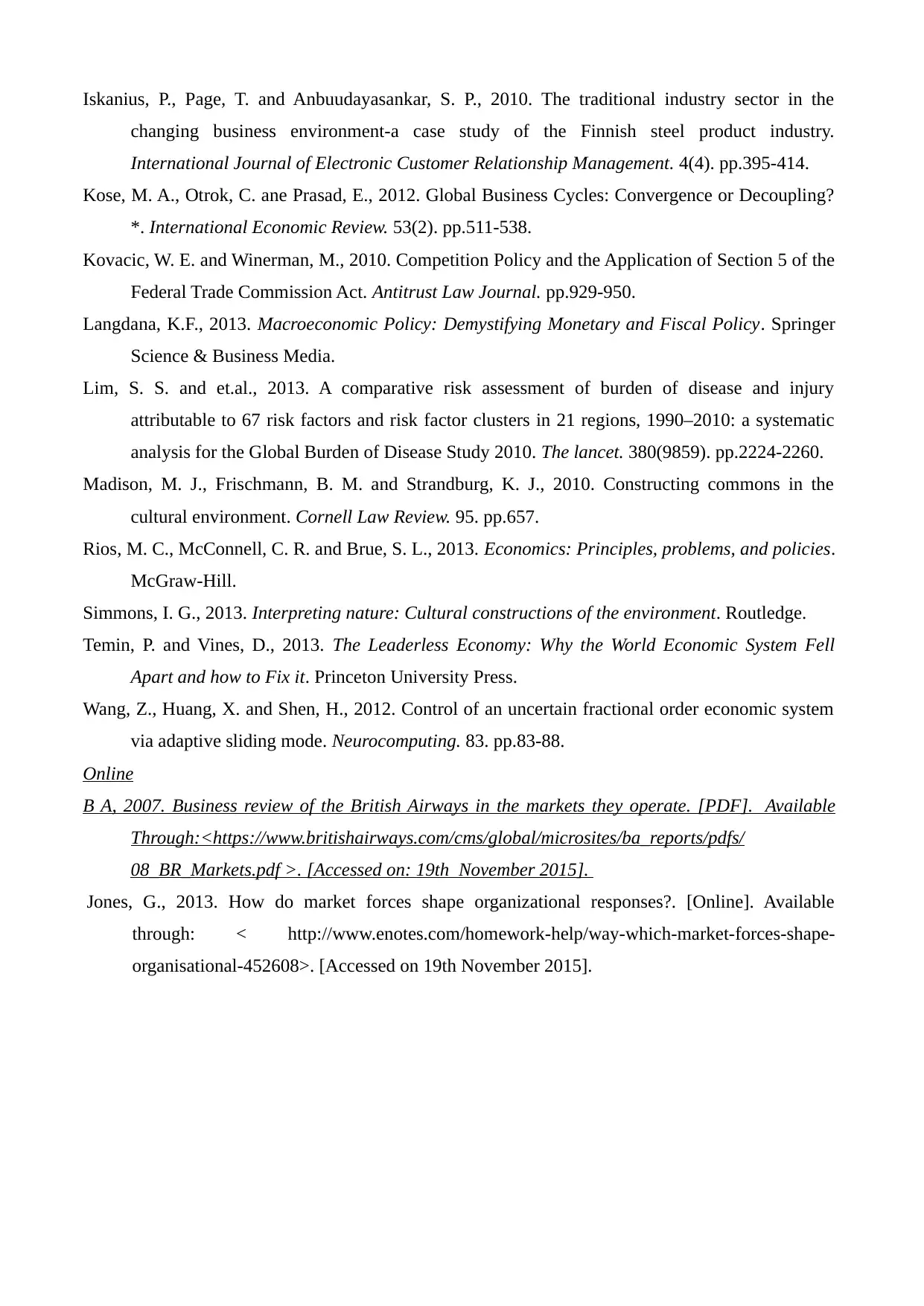
Iskanius, P., Page, T. and Anbuudayasankar, S. P., 2010. The traditional industry sector in the
changing business environment-a case study of the Finnish steel product industry.
International Journal of Electronic Customer Relationship Management. 4(4). pp.395-414.
Kose, M. A., Otrok, C. ane Prasad, E., 2012. Global Business Cycles: Convergence or Decoupling?
*. International Economic Review. 53(2). pp.511-538.
Kovacic, W. E. and Winerman, M., 2010. Competition Policy and the Application of Section 5 of the
Federal Trade Commission Act. Antitrust Law Journal. pp.929-950.
Langdana, K.F., 2013. Macroeconomic Policy: Demystifying Monetary and Fiscal Policy. Springer
Science & Business Media.
Lim, S. S. and et.al., 2013. A comparative risk assessment of burden of disease and injury
attributable to 67 risk factors and risk factor clusters in 21 regions, 1990–2010: a systematic
analysis for the Global Burden of Disease Study 2010. The lancet. 380(9859). pp.2224-2260.
Madison, M. J., Frischmann, B. M. and Strandburg, K. J., 2010. Constructing commons in the
cultural environment. Cornell Law Review. 95. pp.657.
Rios, M. C., McConnell, C. R. and Brue, S. L., 2013. Economics: Principles, problems, and policies.
McGraw-Hill.
Simmons, I. G., 2013. Interpreting nature: Cultural constructions of the environment. Routledge.
Temin, P. and Vines, D., 2013. The Leaderless Economy: Why the World Economic System Fell
Apart and how to Fix it. Princeton University Press.
Wang, Z., Huang, X. and Shen, H., 2012. Control of an uncertain fractional order economic system
via adaptive sliding mode. Neurocomputing. 83. pp.83-88.
Online
B A, 2007. Business review of the British Airways in the markets they operate. [PDF]. Available
Through:<https://www.britishairways.com/cms/global/microsites/ba_reports/pdfs/
08_BR_Markets.pdf >. [Accessed on: 19th November 2015].
Jones, G., 2013. How do market forces shape organizational responses?. [Online]. Available
through: < http://www.enotes.com/homework-help/way-which-market-forces-shape-
organisational-452608>. [Accessed on 19th November 2015].
changing business environment-a case study of the Finnish steel product industry.
International Journal of Electronic Customer Relationship Management. 4(4). pp.395-414.
Kose, M. A., Otrok, C. ane Prasad, E., 2012. Global Business Cycles: Convergence or Decoupling?
*. International Economic Review. 53(2). pp.511-538.
Kovacic, W. E. and Winerman, M., 2010. Competition Policy and the Application of Section 5 of the
Federal Trade Commission Act. Antitrust Law Journal. pp.929-950.
Langdana, K.F., 2013. Macroeconomic Policy: Demystifying Monetary and Fiscal Policy. Springer
Science & Business Media.
Lim, S. S. and et.al., 2013. A comparative risk assessment of burden of disease and injury
attributable to 67 risk factors and risk factor clusters in 21 regions, 1990–2010: a systematic
analysis for the Global Burden of Disease Study 2010. The lancet. 380(9859). pp.2224-2260.
Madison, M. J., Frischmann, B. M. and Strandburg, K. J., 2010. Constructing commons in the
cultural environment. Cornell Law Review. 95. pp.657.
Rios, M. C., McConnell, C. R. and Brue, S. L., 2013. Economics: Principles, problems, and policies.
McGraw-Hill.
Simmons, I. G., 2013. Interpreting nature: Cultural constructions of the environment. Routledge.
Temin, P. and Vines, D., 2013. The Leaderless Economy: Why the World Economic System Fell
Apart and how to Fix it. Princeton University Press.
Wang, Z., Huang, X. and Shen, H., 2012. Control of an uncertain fractional order economic system
via adaptive sliding mode. Neurocomputing. 83. pp.83-88.
Online
B A, 2007. Business review of the British Airways in the markets they operate. [PDF]. Available
Through:<https://www.britishairways.com/cms/global/microsites/ba_reports/pdfs/
08_BR_Markets.pdf >. [Accessed on: 19th November 2015].
Jones, G., 2013. How do market forces shape organizational responses?. [Online]. Available
through: < http://www.enotes.com/homework-help/way-which-market-forces-shape-
organisational-452608>. [Accessed on 19th November 2015].
1 out of 17
Related Documents
Your All-in-One AI-Powered Toolkit for Academic Success.
+13062052269
info@desklib.com
Available 24*7 on WhatsApp / Email
![[object Object]](/_next/static/media/star-bottom.7253800d.svg)
Unlock your academic potential
© 2024 | Zucol Services PVT LTD | All rights reserved.





